John Allore's Blog, page 9
October 19, 2021
Tales from The Douglas Psychiatric Institute for the Insane / WKT5 #18
Remember Dr. Sleep / Gilles Lefebvre from the Real Chartrand episode? Guess where he ended up practicing when he returned from Morocco? The Douglas Psychiatric Institute for the Insane. I’m speaking about the doctor of the patient on leave from the Pinel Institute who over the course of a thanksgiving weekend in 1971 shot and…
Read More on Tales from The Douglas Psychiatric Institute for the Insane / WKT5 #18 »
The post Tales from The Douglas Psychiatric Institute for the Insane / WKT5 #18 first appeared on WHO KILLED THERESA?.October 16, 2021
The Strange Death of the Twin Gynecologists Stewart and Cyril Marcus – WKT5 #17
On July 19, 1975, building handyman, Bill Terrell, responding to complaints of a foul odor coming from a 10th floor locked apartment at 460 E. 63d St. and York Ave. in New York City, discovered the bodies of Dr. Cyril Marcus and his twin brother, Dr. Stewart Marcus. As first reported in the New York Daily News, Cyril was lying face down on the bed in a pair of shorts. Stewart’s body was found on the floor in another room near and identical matching bed, lying face up and completely naked. The handyman told police the place was disheveled, with large amounts of cash scattered throughout the apartment (this later turned out to amount to approximately 22 dollars) though there were no signs of a struggle. One of the armchairs was covered in human excrement. There were conflicting reports of both brothers living in the posh Upper East Side apartment, but the doorman said it was Cyril’s place and only he lived there.
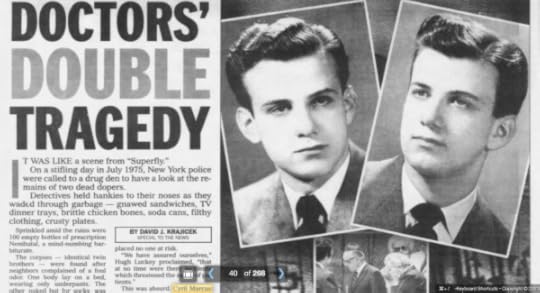 Stewart and Cyril Marcus – New York Daily News
Stewart and Cyril Marcus – New York Daily NewsThe twin brothers were in their mid-40s. The medical examiner stated that, “Very roughly, it seems like Stewart had been dead for four days when he was found, and Cyril had been dead for only two days.” Their deaths were considered bizarre as there were no signs of violence. The medical examiner said that further tests would be done to determine whether they might have died from “some drug or chemical” reason.
The medical examiner’s officer conducted over 30 chemical tests on the bodies of Stewart and Cyril Marcus and still were not able to determine what killed the twin gynecologists. Despite reports that their apartment was littered with rubbish including liquor and prescription drug bottles ( by one report over 100 drug bottles), there were no traces of alcohol, barbiturates, narcotics or depressants in their systems.
Doctors Cyril and Stewart Marcus were nationally known physicians affiliated with the New York Hospital-Cornell Medical Center (today part of the medical complex that occupies several city blocks at 68th and York – Cornell Medical College, Sloan Kettering Cancer Center, etc…). The twins bore the titles of clinical assistant professors of obstetrics and gynecology and were co-directors of Cornell Hospital’s Infertility Clinic. They both published influential articles in some of the leading medical journals.
Some pointed to stressors and changes in recent months. Dr. Stanley Birnbaum of New York Hospital reported to the New York Daily News that the doctors were, “very dedicated, quiet and conscientious,” but that “they seemed to be having some emotional problems over the past year.” A 10th floor neighbor at their Sutton Terrace apartment put it more bluntly: “They were pretty weird.” The doorman at an East Side apartment where Cyril would often pick up his two daughters at his ex-wife’s apartment commented, “two years ago, he looked fine. But lately he looked awful – rundown, skinny. Since last summer I’d say he lost at least 20 pounds. He looked gaunt, very ill.” Staff at New York Hospital said that Stewart Marcus had always remained a bachelor.
Old WorldIn the fall of 1975, Linda Wolfe wrote an article for New York magazine called, “The Strange Death of the Twin Gynecologists”. Wolfe was an essayist, and is best known for her book, Wasted: The Preppie Murder, about the 1986 murder of 18-year-old Jennifer Levin, who was found strangled in Central Park adjacent to the Metropolitan Museum of Art. Robert Chambers was quickly arrested, the two had once dated, and had been seen together the prior evening at Dorian’s Red Hand, a bar near the museum at 84th Street. Wolfe had once been a patient of Stewart Marcus. She had experienced first hand the doctor’s odd behavior. During one visit, Stewart Marcus began to “shout and scream” at Wolfe, until her husband intervened and the couple stormed out of his office.
 The Strange Death of the Twin Gynecologists – Linda Wolfe
The Strange Death of the Twin Gynecologists – Linda WolfeFor years, both brothers had been taking massive doses of Nembutal, but as there were no signs of drugs in their systems at the time of death, medical experts ultimately concluded that the twins died from withdrawal after a desperate attempt to kick their prescription drug habit. Some questioned this ruling as there were no typical signs of withdrawal at the time of death – no bruising, tongue biting, or brain hemorrhaging. New tests were conducted and the determination was revised to conclude that Stewart could have died from withdrawal, but not his minutes-younger brother, Cyril. How did Cyril die? Even stranger, Cyril had outlived his brother by several days, and was observed leaving the apartment, only to ultimately return and die later alongside Stewart. Why did Cyril leave the apartment, and then why did he decide to return?
——————–
The twins grew up in 1930s Binghamton, New York, then later Bayonne, New Jersey. Not identical twins, though the two looked alike, the brothers were always together from childhood through their school years. Neither were athletic. No footballs for the Marcus brothers, their physician father bought them a chemistry set. They enjoyed playing doctor. “They didn’t seem to need anyone but each other.” a classmate remarked. The twins wore similar white shirts, with ties and jackets. “They were formal all the time, as if they couldn’t bear to face the world without putting on some kind of a mask.” Stewart’s one-time fiancee offered, “The twins were snobs”.
After medical school, when the Marcus brothers began their medical residencies together, a fellow student remarked:
“They were schizoid…. When they talked to you – and most of the time they didn’t talk to anyone, just to one another – you got the distinct impression that their responses were artificial, that they didn’t really have emotions that other people did, but were aping others’ emotions, trying to imitate them.”
Linda Wolfe, The Professor and the Prostitute and Other True Tales of Murder and Madness, (New York, Open Road Media, August 26, 2014), 121
Former patients were similarly troubled. One woman who eventually gave birth to twins commented how Stewart, her obstetrician, greeted the impending news with contempt and distain, “… it was as if giving birth to twins was something too special for the likes of me.” Offered another:
“Having them in attendance was horrible. One checked with his fingers to see how far I was dilated. Then he called his brother, and had him check too. Then they did it again. It was painful enough to have one person checking the dilation, excruciating to have two people doing it. It was also, I should add, totally unnecessary. But they did it anyway. It was as if one couldn’t bear to do something without sharing what he was doing with his brother.”
Linda Wolfe, The Professor and the Prostitute and Other True Tales of Murder and Madness, (New York, Open Road Media, August 26, 2014), 122
Only once did the twins separate, when Stewart transferred briefly to University Hospital at Stanford. Within a year he was back in New York and started a private practice with Cyril. In the 60s their medical practice prospered. They did research and published in many scientific journals. They co-authored what was considered a classic textbook, Advances in Obstetrics and Gynecology. It’s not known at what point prescription drugs entered their lives, but by the 1970s they had become addicted to barbiturates and amphetamines. All the while delivering babies and performing medical procedures. Their behavior became arrogant and erratic. One day Cyril threw a tray of sterilized instruments at a patient. He would often call patients from restaurants like P.J. Clarke’s and ramble on with stories such as the one about a woman he claimed to have treated for the after-effects of having sex with a large dog.
Their building handyman, Bill Terrell believed that in 1972 Cyril suffered an overdose. Terrell was passing through the hallway when he heard a buzzing coming from inside Cyril’s apartment. He knocked, then pounded on the door but no one answered. Alarmed, Terrell immediately called Stewart, telling him, “There’s something not quite kosher at your brother’s place. I think he needs your help.” Terrell said that Stewart then put down the phone for approximately 90 seconds. Terrell said he had the feeling that Stewart was somehow, “consulting the air waves, communing with his brother.” (others have speculated he may have also been considering to cut ties with Cyril then and there, or merely taking the time to pull himself together, no doubt being in a drug-induced state of his own). After what seemed like an eternity, Terrell finally heard, “You’re right. He needs help. I’ll be right over.” Stewart and Terrell found Cyril lying fully clothed and unconscious in the foyer of his apartment. He was resuscitated, hospitalized, then quickly back at his practice seeing patients, though it has been suggested that Cyril suffered a stroke during this overdose that may have caused brain damage.
By 1974 their once crowded waiting room had emptied. The office grew dirty, the rent went unpaid, the brothers’ speech slurred. The medical profession has always been slow to deal with problems amongst its own for fear of a lawsuit, but by 1975 the chairman of obstetrics and gynecology at New York Hospital, Dr. Fritz Fuchs, gave the Marcus brothers an ultimatum: get treatment or resign. The twins opted to kick their drug habit alone, without assistance. They isolated in Cyril’s apartment, stocked with TV dinners and anticonvulsive medication. At some point, one of them went to a drugstore to pickup a barbiturate prescription. Sometime between July 10 and July 14, Stewart overdosed on Nembutal and died.
And this is were things get even weirder. After Stewart’s death the doorman of the apartment had an encounter with Cyril. The younger twin appeared to be trying to escape, making his way out of the building. The doorman noticed Cyril’s disorientation and frailty and offered to help. Cyril curtly brushed him aside with, “I can manage on my own”, but once out in the street, he quickly retreated back into the apartment. Back with Stewart, Cyril left a kind of a suicide note. He placed a copy of the Iris Murdoch novel, A Fairly Honorable Defeat face down in the middle of one of the rooms. The book is about two brothers, and a mischievous and satanic figure named Julius who makes a bet he can break up the relationship between a homosexual couple. Other than medical works, it was the only book found in the apartment. After placing the book, Cyril appears to have simply lied down and waited to die.
Misfit KidIn the fall of 1987, I arrived in New York City. I wanted to study acting, and got accepted to the Neighborhood Playhouse School of the Theatre. Some friends of mine, Greg and Kenton, from my University of Toronto days, were now doing graduate work at Sloan Kettering and offered up their couch in their student housing apartment, located at 70th St. and York Ave. I think I arrived by train via Grand Central Station, then took a cab to the Upper East Side.
Manhattan in 1987 was still not so different from New York in the 70s. The Deuce was not yet gentrified. It was unsafe to walk through Central Park at night. There must have been a garbage strike, I remember mountains of debris piled along the curbs. At night the rats would follow you for several blocks.
Coming from Toronto, I knew crime, but not American type crime. Everyone remembered the Alison Parrott murder. The 11-year-old girl had been lured to Varsity Stadium the previous summer, her remains found two days later in the woods near Etobicoke. Greg, Kenton and I had lived in a dorm behind Varsity Stadium. We all remembered that. But we had never experienced anything like the ‘the preppie murder‘. Robert Chambers’ legal process was playing out in the New York courts in the fall of 1987. It was hard to ignore the 24-hour updates in the New York Post and Daily News. Chambers was roughly our age. He dressed nice. He didn’t appear like the sort of sex pervert we’d been told all our lives to watch out for. I know at some point we all found ourselves at Dorian’s Red Hand, the 84th Street bar where Chambers and Jennifer Levin were last seen before Chambers strangled her. Finishing our beers, we did not then venture to the crime scene together. That I did alone. It was a grassy area in the south shadow of The Met ( today, near the Group of Bears sculpture). Chambers would later try to explain it was all some kind of misunderstanding – Jennifer had enjoyed rough sex. Chambers’ skin was found under Levin’s fingernails, where she had gouged him, attempting to stop him from strangling the life out of her.
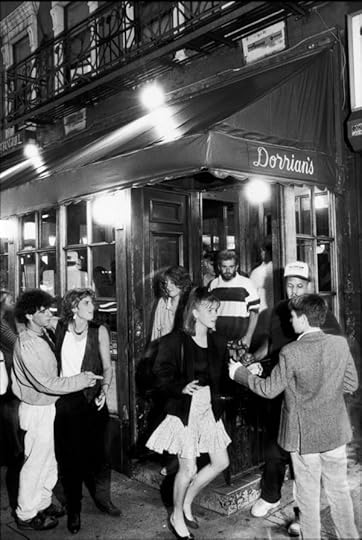 Dorian’s Red Hand in the 80s – Getty Images
Dorian’s Red Hand in the 80s – Getty ImagesI did not often come that far west to the eastern edge of Central Park. My morning commute each day in 1987 was a sixteen block straight-shot down York or First Ave. Recently I Googled my walk to school, but there was little I recognized. Diners have been replaced with Starbucks. Everything appeared bigger, and higher. I remember along First, just before the Feeling Groovy bridge there was a run of a Chippendales, a TGI Friday’s, then finally some comedy club – Comedy Works or Comedy Store or something. Early in the mornings there was always a lot of puke from the previous evening, and some poor slob would be out front hosing it down. Then you’d cross under the 59th Street bridge, that little parkette from Manhattan would be on your left. A few more blocks and you’d reach 54th, where The Playhouse was located.
The Neighborhood Playhouse, and its acting founder, Sanford Meisner, were most famous for teaching Robert Duvall and Diane Keaton. First year was a little like the military where they’d strip you down then slowly build you back up. Full Metal Jacket was coming out then, and my teacher was a lot like the Gunnery Sergeant in that film. Robert Modica was a chain smoking, former Marine, and self-proclaimed former Jesuit. He looked a little like the actor, Robert Loggia. Modica yelled a lot, there were a lot of fists slamming of tables, and he would give speeches about our fallen boys at Anzio, Iwo Jima, Saipan and Guadalcanal. It was only years later when I realized that these sermons were modified versions of the William Demarest bar speech from Preston Sturges’ Hail The Conquering Hero.
At that time, everyone wanted to study at The Neighborhood Playhouse. One day I came in the front door and there in the dimly lit lobby – the whole place was dimly lit, like someone went around remove every second lightbulb to save on the electric bill – was Joan Rivers and her teenage daughter, Melissa looking like Regan from The Exorcist. I don’t know if Melissa wasn’t good enough or lost interest, but I never saw her again.
I would learn later that of course they all had lived in that midtown neighborhood. Rivers was near 54th and 1st, her friend and celebrity hairstylist, Ken Battelle lived a block up on 55th, his studio, Kenneth’s was located further down 54th at Madison. Battelle was responsible for reviving Marilyn Monroe’s look in the late 50s, so of course she had lived at close range at 57th near 1st. Then her friend, Monty Clift had been only a few blocks away at 61st and 3rd. Further up on East 72nd Street was the clinic of Max Jacobson, the original Dr. Feelgood. Jacobson supplied everyone from Monroe to JFK with methamphetamines, and was the de-factor pill consultant for the film adaptation of Jacqueline Susann‘s Valley of the Dolls (co-staring the up-and-coming Sharon Tate). Jacobson got busted in 1972 for peddling speed. It was the opioid crisis of its time, an era when highly lethal prescription drugs administered at the hands of your doctor was de rigueur, and certainly self-medicating doctors was the norm.
Most of these people and places have vanished. I was surprised to find that one had survived. The Madison Restaurant (in the late 80s it was the Madison Food Shop) is still located at the northwest corner of 53rd and 1st. Many a breakfast was shared here before class. I once sat across a booth occupied by Bill Murray and Sydney Pollack, the Tootsie director and occasional actor was a decade away from appearing in Kubrick’s Eyes Wide Shut. If you walked a few blocks south toward the United Nations there was one of the last Horn & Hardart automats in the city where you could drop some change in a slot and get an egg salad sandwich or piece of pie. I heard they turned it into a Burger King.
I recently talked to my friend Kenton, because I couldn’t remember much about the area where we had lived at 70th and York. He said we liked a bar across the street called Nimrods. It was one of those places in the basement of a brownstone, you’d walk down a flight of stairs into this urban cave. The owner, Wolfgang, was one of the last to resist televisions above the bar. We’d sit there a do shots of Jägermeister, a novelty at that time. There was also the obligatory NYC pizza place, “It was run by an old guy who threw dough in the air in the classic way, who was seriously drunk all the time and had burn marks from the oven on his arms.” Then I asked Kenton about the Marcus brothers. He had worked at New York Hospital, possibly occupying the same lab space as the twin doctors, Stewart and Cyril – had he heard any stories?:
Memories Can’t Wait“No personal stories. I remember being absolutely haunted by that film and reading some bio stories (probably in NY magazine) about them when the film came out.”
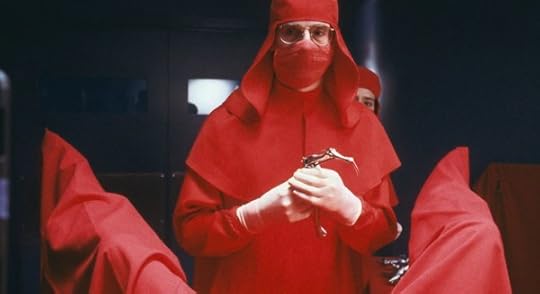 Jeromy Irons – Dead Ringers
Jeromy Irons – Dead RingersThe film of course is Dead Ringers – David Cronenberg‘s psychological horror thriller about the twin gynecologists, played by Jeromy Irons, and in the movie called Beverly and Elliot Mantle. Cronenberg was influenced by Linda Wolfe’s New York magazine article – as well as a fictionalized account in the novel, Twins. Cronenberg earned some flack for the tabloidesque title, but Dead Ringers is actually the name of a 1976 Esquire piece written about the Marcus brothers by Ron Rosenbaum and Susan Edmiston (essentially an expanded retelling of Wolfe’s 1974 article). For the most part, Cronenberg sticks to Wolfe’s script. We see the young Mantle boys given a chemistry set, and playing doctor with a neighborhood girl (Toronto’s modest Annex neighborhood stands in for the New Jersey suburbs). The deterioration of their practice is portrayed as we watch Irons slowly unravel. It’s all pretty much by the book until it isn’t, and things take the inevitable Cronenberg turn. Beverly enlists a downtown artist to create some new surgical instruments that come out looking like medieval weapons of torture. He then attempts to perform an operation on a woman using the instruments, the scene ends with him being unable to breath and lunging for the patient’s gas respirator (In reality it was Cyril Marcus who once launched himself across the operating table grasping for a patient’s anesthetic mask. Cyril also once attempted to perform a circumcision using the dull handle of a surgical instrument.). Fans of Cronenberg would instantly recognize the reference to his previous film, The Fly, when Ronnie (Gena Davis) has the nightmare of giving birth to a grotesque insect pupa. The gynecologist conducting the procedure is played by David Cronenberg. By the time we move to Dead Ringers, Irons – covered head-to-toe in red-death robes and surgical mask with only his glasses showing – is now a dead ringer for Cronenberg.
I had seen the world premiere of Dead Ringers at Toronto’s Festivals of Festivals in the fall of 1988, but I had not made the connection, nor had anyway of knowing at that time that the real gynecologist twins had lived down the street from me on the Upper East Side of Manhattan. I had walked past Cyril’s apartment at 460 E. 63d St. and York Ave. on an almost daily basis for close to a year. Had I arrived a decade earlier, I might have even mingled with them in a drug store, or seen them grabbing a slice at ‘Burnt Arm Guy’s Famous’.
The film rather closely tracks the ending of Doctors Stewart and Cyril Marcus. Beverly / Cyril attempts to leave the now deceased Elliot / Stewart. He goes outside and calls his ex-lover Claire, played by Geneviève Bujold ( a shared love interest of the twins, one of the less convincing elements of the film, and there are several) from a pay phone. Claire asks, “Who is this?”. Beverly hangs up the phone, retreats indoors, and waits to die in his twin brother’s arms.
Even in life, as in art, things got mixed up. The Dead Ringers Esquire piece, written two years after the twins’ discovery, reported that for months the media got it wrong in reporting that Cyril was found on the bed, and it was Stewart on the floor. It was in fact the other way around, which leads one to wonder which twin in fact died first, and precisely which brother actually ventured out into the world? At at this point, does it even matter? They had been born minutes apart and were known to frequently impersonate each other. Some have even speculated that the Marcus brothers weren’t even twins, but promoted themselves as such to give an air of wonder and uniqueness.
The Esquire article suggests an even more macabre folie à deux played out in the summer of 1975:
“The remnants of their last days together suggest that in some respects the twins lived out a kind of nightmarish children’s party. There were dozens of bottles of sweet soda pop all over the place—wild cherry, strawberry, vanilla cream, Rooti root beer, Coca-Cola. There were cookies, cakes, and ice cream, too. And they never had to clean up.”
Ron Rosenbaum and Susan Edmiston, DEAD RINGERS A bizarre case of the death of twins, Esquire, March 1, 1976
Linda Wolfe’s essay on the Marcus brothers can be found in her collection of stories, The Professor and the Prostitute and Other True Tales of Murder and Madness. The lead off piece concerns the 1983 bludgeoning murder of a Boston sex trade worker, Robin Benedict at the hand of her john, former Tufts University professor William Douglas. It is another tale of obsession and identity, a locus of writing Wolfe excels at. Douglas was introduced to Benedict at a bar in Boston’s red light district known as the combat zone, and from that point it seemed inevitable that his destiny would be to eventually kill her. Wolfe has an acute understanding of this stark element of social behavior. So does Cronenberg. From Videodrome‘s Max Renn to Johnny in The Dead Zone to Seth Brundle and the Mantle brothers, inevitably it is the fate of every Cronenberg hero to hole-up somewhere and wait for death or rebirth. Here’s how Wolfe concludes her New York magazine piece on Stewart and Cyril Marcus:
“Many people I spoke with after the twins died felt that there was something mystical about Cyril’s behavior and suggested that he had been, in effect, almost drawn against his will to share his brother’s fate. It made me realize that some primitive terror of twins still lurks in contemporary man. We have come eons away from the kinds of superstitions that drove aborigines of Australia to murder one or even both of a twin set at birth, that prompted some West African tribes to kill not just twin infants but the women who had given birth to them. But some of us (perhaps the Marcus brothers themselves) nevertheless attribute to twins superhuman sensitivities like extrasensory perception or the ability to communicate without words. And when these doubles, born on the same day, die at the same time, their fate arouses in us an almost primordial anxiety.
… The simultaneous or nearly simultaneous death of twins happens rarely, but when it does, it seems like some mysterious arithmetical proposition far beyond the ordinary computation involved in life and death, and it so frightens and unnerves us that we seek extrarational explanations.
But mysticism is unnecessary in the case of the Marcus brothers. The explanation for their nearly simultaneous deaths lies in the extraordinary attachment they felt toward one another and the extraordinary disregard they felt for the world of singletons.”
Linda Wolfe, The Professor and the Prostitute and Other True Tales of Murder and Madness, (New York, Open Road Media, August 26, 2014), 133
CODAAs a conclusion, it took a lot of work remembering 1987 New York. I know we were all reading Jay McInerney and Tama Janowitz as the new and fresh literary things. I had to pump my friend Kenton to get the noggin movie-engine running. I found some journals I had kept from those New York years. A lot of what I wrote was about my experience at acting school, but my inspirations on Brando or Duvall or anything that Sandy Meisner taught us about his method was not going to light a candle. What I did keep that is interesting is the names of people and places, specific dates and addresses. The only reason I remember the Madison Food Shop is because I wrote it down, and I was shocked to find it still thriving at 53rd and 1st. There’s an entry from April, 1988 that reads:
“Gallery at 57th and 5th Ave. for Vince’s showing tonight 6:00 p.m. – 8:00 p.m.”
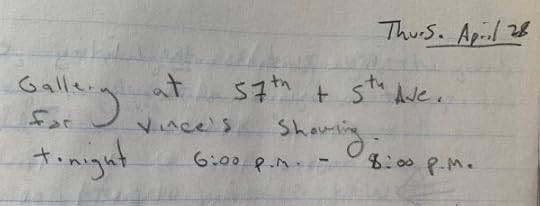
This is a reference to the American painter, Vincent Desiderio. At the time, Vince was struggling to find his way in the New York art world. My friend, Greg knew him best, and we would often show up at his openings to show support. Once, the three of us served as artist models for one of his paintings. He brought us to the roof of an East Side apartment, and had us pose in the snow while he sketched. One of us served as a dead body lying in the snow, the other two were observers standing over the body. I think I was the dead body.
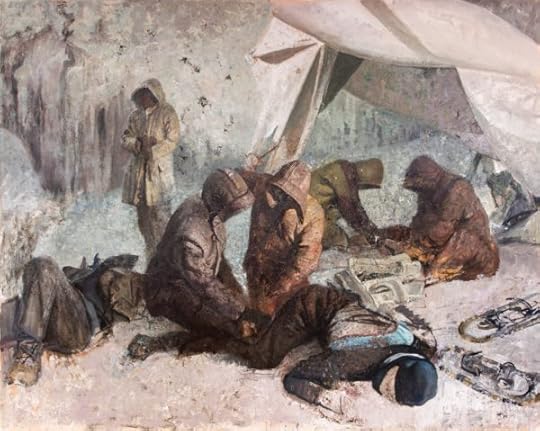 Men in Snow – Vincent DesiderioThe post The Strange Death of the Twin Gynecologists Stewart and Cyril Marcus – WKT5 #17 first appeared on WHO KILLED THERESA?.
Men in Snow – Vincent DesiderioThe post The Strange Death of the Twin Gynecologists Stewart and Cyril Marcus – WKT5 #17 first appeared on WHO KILLED THERESA?.
October 2, 2021
Something Fuckeried This Way Comes / WKT5 #16
I once received an email from a psychic from western Canada who said she was meant to contact me, that she had certain information regarding the unsolved murder of Marie-Ève Larivière. Recall that on March 7th, 1992, 11-year-old Marie-Ève Larivière went missing while running an errand for her family in Laval. Her body was found near some railway tracks within 12 hours. She had been strangled and sexually assaulted. The psychic – we’ll call her Hannah – said she received information directly from Marie-Eve. In 2015 she had shared her information with the Laval police. They appeared uninterested. She was now turning to me because., “I think I am meant to contact you”. Hannah had no connection to Quebec, showed little interest in the provinces cold cases, and only tracked me down by doing a Google search on Marie-Ève Larivière. I get a lot of people contacting me claiming psychic abilities. One woman once wrote only because she said she was new to the awakening of her abilities and wanted to “practice” on my sister’s case. I take these things with a pound of salt. This is what Hannah told me and the Laval police:
“Prior to the spring of 2015 I had no knowledge regarding the case of Marie Eve Lariviere, or any of the other cases of the missing and murdered children now possibly linked to the same perpetrator. I had a very lucid, vivid dream that I recognized as a vision not a regular dream. I am aware I am dreaming and have control over my actions. It begins I am in a house and I am me but I am younger, like a young teen maybe. I see somewhere between 15-25 children fading in and out, like ghosts, but they are not fading in and out all at once, kind of like one after another. I knew this meant they were dying, murdered to be specific. I could only make out general features as it was happening quickly and they were literally transparent looking. The children were all between the ages of roughly 4-14. There was an almost equal mix of genders. Eventually they all fade out and there are only a few kids left kind of floating around. Because I saw all the children in this house does not mean they died there, I believe this is the house of the perpetrator(s). I see a man and a women sitting on the couch, I am aware they are the ones responsible for the deaths, the man is the main culprit. He is around 50 years old ( I see this as a current age). He is dumpy looking, his belly hangs out of his shirt. The woman is around 45 years old, she is also dumpy looking, not well kept. Both persons are mentally ill, they are capable of looking after themselves and all but have psychiatric issues. It is like they are collecting these children in some way, not for any rational reason of course. They keep taking these kids to fulfill something but they also feel killing them is necessary for sick illogical reasons. People would know who they are see them as just strange. They do not socialize with others or neighbors. I believe they are a couple, but not married.
They cannot see me…..but I feel like I should still sneak around (someone else’s feelings I believe I am feeling). Next I am lying on the floor like dog, I feel lethargic and very thirsty and I am thinking (again feeling someone else’s feelings) if I am quiet and lay still maybe they will see me as good and nothing bad will happen and maybe they will give me a drink of water.
I realize I need to find a way out of the house without being detected so I start to look around. I go from the living room to the hallway and I stop as I see someone coming down the stairs, it is a little girl, but she is a ghost. She looked different than the other children I had seen. She was not taking steps but more floating down the stairs. As soon as she was fully in sight she turned and looked at me straight in the eyes as she slowly passed by from down the stairs to the opening to the living room. The hair on my neck stood up, this was another indicator to me she was real but not alive. She appeared to be about 9 years old. She was wearing a white or lighter colored dress. She is thin and has a small frame. Her hair is a medium brown, just past her shoulders almost to the middle of her back. It is wavy and thick. She has bangs and only the top part of her hair is pulled back. I did not follow her, it scared me. So I turned to go towards the front door.
Once at the front door I notice a short china hutch or some kind of table or stand. On it are what appear to be little trinkets with names. I start to read the names and look at the items. I am thinking this is strange….what is this? Then it clicks that these are mementoes. I read a handful of names and looked at the items. Once I realized what it was I started to panic, my heart was pounding and it was too much to handle. Unfortunately I didn’t record these details upon awakening, if I had known the significance at the time I surely would have. The only names and items I can recall are a pair of earrings I saw with the name Tiffany or Tammy, and the name Maurice but I cannot remember what item was with his name. I know that Maurice is a young white male around 5 or 6 years old.
At this point I am feeling traumatized and overwhelmed, I looked out the front window for several seconds staring at a tree in the front yard with a crooked looking branch that hangs lower blocking view of what is past it.
This is where the dream basically ends, I wake up with my heart still pounding.
To detail the house I know it is in a small community, maybe right on the outside of one. There is a field that basically starts at the end of the back yard. It is large, like acres and acres of field. The front of the house has lots of trees but I don’t know what is past them. Directly right (when looking out the front door) is a neighbors house, it looks like it needs a paint job. I think it was like a pale blue green color. Nothing I can see to the left, not sure of the closest house or structure. I feel like it is a 1 1/2 story house but I can’t be certain of that. Inside there is a main level and upper level. I have attached a hand drawn floor plan of what I saw.
This dream bugged me so I started to look into it. I figured it was within North America because of the geography and the style of the house and items and furniture in it. Also I figured the name Maurice wasn’t that common so I had a couple things to go on. Eventually I came across the case of Maurice Viens and it led to all the other cases and things started seeming very similar with what I had been shown through that dream. I thought it possible it could be the same thing but who knows. It wasn’t until last month when I decided I needed to contact someone. I saw a photo of Marie Eve Lariviere for the first time and she was the dead little girl staring into my eyes in that hallway. I felt like throwing up. A couple weeks ago out of nowhere while driving to the store I receive the word Charlemagne. I asked my husband “what’s a Charlemagne?” He says he doesn’t know and neither did I so I didn’t put anymore thought into it. The next morning as soon as I wake up I am feeling urged to look at a map of the area where all these murders have been happening for whatever reason. What’s the first thing I see…..Charlemagne Quebec! I am sure I swore and proceeded to google if there was any other Charlemagne even in different spellings. Nothing that applies to me receiving a random word besides Charlemagne Quebec. The only other info I received is the name Martin, repeatedly. Personally I believe very little in life is actually coincidence. I am not sure how the name is connected but I know it is somehow because I hear it with a french accent.
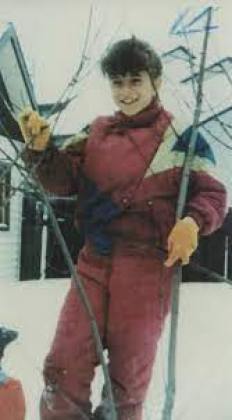 Marie-Ève Larivière
Marie-Ève Larivière
In closing I would like to assure you I am an honest mentally sound person, this is not a sick joke and I truly hope something good will come from the information I have been given to pass onto you. I honestly feel it has been Marie Eve Lariviere guiding me since this past spring……as strange as it may sound. I can see dead people, I can speak to dead people and they can speak to me. I can also see past events. All my life this has been happening and I have had been able to find information on certain things that confirm my accuracy, I guess you could call it. I know psychic type visions are tough to be credible a lot of times and I am sure you get many of these types of tips….”
Certainly, “Maurice” could be Maurice Viens – a 4-year-old boy who disappeared from the streets of Montreal, his remains were found in a barn on the outskirts, November 6, 1984. “Tiffany” or “Tammy” might be Tammy Leakey, a 12-year-old girl abducted from Pointe Saint Charles whose body was found near the Dorval airport in 1981. The dumpy looking man could be the offenders, Claude Larouche or Richard Bouillon. Viens, Leakey and Lariviere all appeared in stories written in 2013 about the possibility of a serial killer being responsible for the deaths of seven children in the Montreal area in the 1980s. and 90s. The story, “Quebec police believe serial killer behind 7 cold cases”, made national headlines, including Canada’ National Post newspaper. Hannah contacted Laval police two years later in 2015, so it’s possible her dream was influenced from reading the newspaper story. Possible. There’s a great episode of The Rockford Files where Jim tries to unmask a medium he believes is misleading the LAPD, but you’re never quite sure whether the Great Clementi – A Los Angeles version of Reveen The Impossibilist or The Amazing Kreskin – is hoodwinking the police, or blind to his own self-manipulation, or truly possesses psychic insight.
Anyway, today’s story isn’t about a psychic we call Hannah. It’s about how we sometimes shine or vibe or fixate on things or people or places. For me it’s a place – rather a region. A peninsula formed by the merging of the Ottawa and Saint Lawrence rivers in the southwest region of Quebec and Ontario. For me, a spooky place, my mind often travels there.
———————
Pattern RecognitionIn her message to the Laval police – who by the way were totally uninterested in her information, I don’t think they even bothered to respond – Hannah mentioned a drawing she had made of the floor plan of the house from her dream. Hannah came to believe that the house did not belong to the dumpy couple, but was in fact the childhood home of Marie-Ève Larivière. She managed to track down that house on Google. Interestingly, Marie-Ève did not live in Montreal or Laval. She resided in a country home far to the west of Montreal in Sainte Polycarpe:
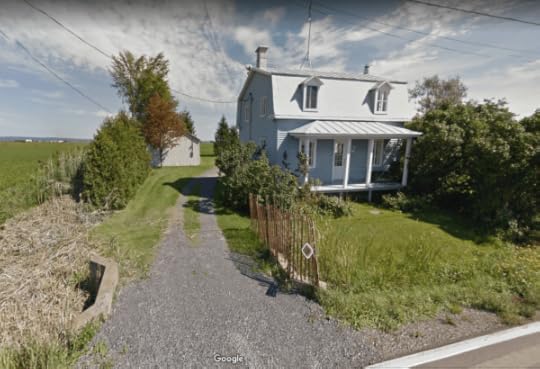 2972 Chemin Sainte Marie, Sainte Polycarpe QC
2972 Chemin Sainte Marie, Sainte Polycarpe QCMarie-Ève Larivière’s home was never discussed in any national news article. Indeed, it took quite a bit of sleuthing for me to track it down. It is very much like the description in Hannah’s fever dream – a very rural setting, large acreage, a fair amount of trees and bushes. It is a modest 1 1/2 story house. There’s no house needing a paint job to the right, in fact there’s nothing left and right but fields and open country. It’s weird. It looks very much like Orange County, North Carolina, and the back roads where I cycle every day. This is why in the episode, Hyperthymesia from last summer I mentioned Marie-Ève Larivière. When you cycle, the mind wanders. I find myself looking out for that house, like Natalie Wood’s frantic search at the conclusion of Miracle on 34th Street. It’s not unusual. At the crossroads of Woodcrest Farm there is an outbuilding that looks exactly like the wooden garage outside Ste. Therese where Carole Dupont’s body was found in the snow in 1974 – pattern recognition.
 Hannah’s map
Hannah’s mapHannah later wrote:
“There are some details I see a little different now due to my own interpretation of the experience. But one I still can’t find anything about or any connection to is the town Charlemagne. I received that word or name one day and I know there is a strong connection with this case or the whole possible serial killer related to this/these case(s). I want you to know this in particular, Charlemagne is significant… Another detail that gave me literal chills is how in your podcast you say Marie-Eve had felt like she was going to die in a bad way or something to the sort……This is significant for me as she is obviously a “sensitive” person, which would explain how she was able to communicate with me so well. Not all spirits can do that. I asked the question to myself back in 2015, why did she talk to me and how is she able to so clearly, she has strong capabilities relating to mediumship I concluded. These capabilities typically remain the same for person whether alive or dead. So when she was alive she would have been a sensitive person to other worldly things. For her to be able to potentially foresee (feel) her death, even vaguely is huge for me. “
Charlemagne is an interesting area. It borders Terrebonne, at the very tip of the east end, off the island of Montreal. Terrebonne is where Julie Surprenant disappeared in 1999, the deceased offender, Richard Bouillon has long been suspected in her disappearance, he lived in the apartment above her. But the murderer Claude Larouche, convicted in the 2009 strangulation murder of Natasha Cournoyer, for a time also lived near Charlemagne. In 1989 Larouche was living in an apartment at 97 Richelieu in Repentigny, the community just east of Charlemagne.
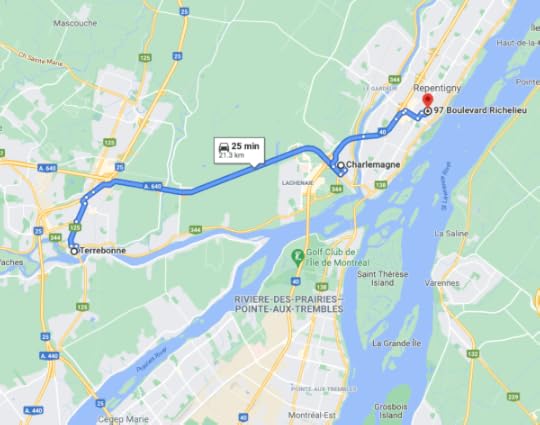 Maps and LegendsReturning to Saint Polycarpe
Maps and LegendsReturning to Saint PolycarpeI often drive to Quebec. My usual route takes me through New York or New Hampshire, depending if I’m traveling to Montreal or Sherbrooke. More recently – prior to being contacted by Hannah – I’ve begun taking a new route, crossing the Saint Lawrence at Cornwall, Ontario, and coming through the back channels of Quebec to avoid metropolitan Montreal. This new route takes me very close to Saint Polycarpe, crossing the Ottawa river at Hawkesbury. My last exit before getting off the highway is Ste Therese, Quebec. The offramp is adjacent to the mall where in 1994 the body of 10-year-old Marie Chantale Desjardins was found in the woods behind the mall. Claude Larouche is a suspect in that murder – and the mind wanders.
Hawkesbury is interesting. Last spring, Stephane Luce’s group, Meurtres et Disparitions Irrésolus du Québec – MDIQ put up a billboard in Hawkesbury for information concerning the 2011 disappearance of Marilyn Bergeron. Although she lived in Montreal, and was last seen near Quebec City, information has come forward suggesting Marilyn might have actually been held captive in the Hawkesbury region as part of a sex trafficking ring. Now Gaston Lapage is a member of MDIQ, and resident of Hawkesbury who recently started an Ontario chapter of MDIQ. Recently Gaston put up a similar billboard on his brother’s land in nearby Fournier, Ontario looking for information on the death of Jessica Godin, victim of a hit-and-run in 2011.
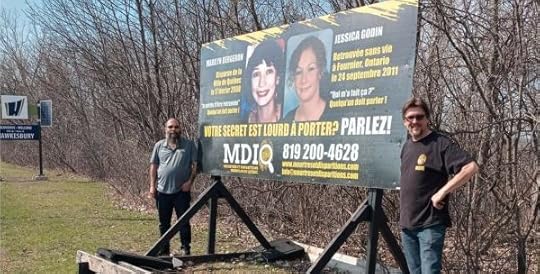 Marilyn Bergeron and Jessica Godin billboard near Hawkesbury. Gaston Lepage and Stephane Luce pictured.Offramp
Marilyn Bergeron and Jessica Godin billboard near Hawkesbury. Gaston Lepage and Stephane Luce pictured.OfframpHave you heard of the Casselman / Nation River Lady case? Around 10 a.m. on Saturday, May 3, 1975, farmer Claude Legault was repairing a fence when he came upon the body of a woman floating face down beneath the 417 highway overpass crossing the Nation River near Casselman, Ontario, about 30 kilometres southeast of Ottawa, and 80 kilometres west of Saint Polycarpe. Officers from the Long Sault Ontario Provincial Police force (OPP) determined the victim had been strangled, with her hands and feet bound by neckties before she was dumped in the river approximately two weeks to a month before being found. The victim was naked, except for a blue blouse which was fully buttoned up the front. She was believed to be between 20 and 30 years of age, five feet and three inches tall, with long bleached blonde hair, and weighed approximately 115 pounds. The autopsy would reveal that she had not been sexually assaulted, and had been strangled with an antenna wire.
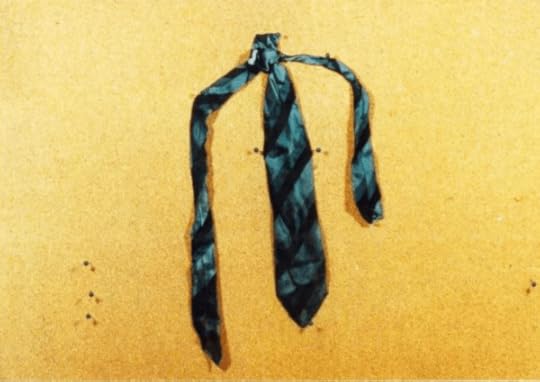 Necktie number 1 / Nation River Lady
Necktie number 1 / Nation River Lady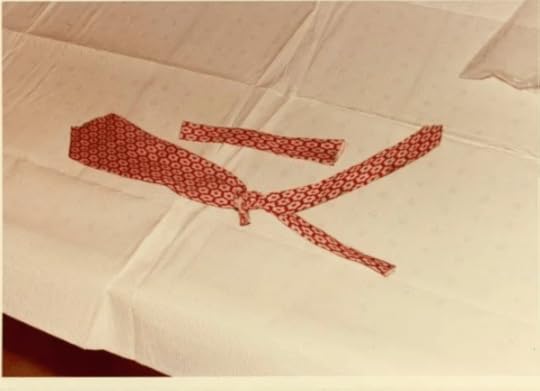 Necktie number 2 / Nation River Lady
Necktie number 2 / Nation River Lady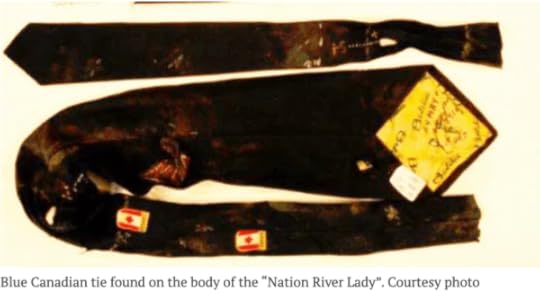 Necktie number 3, the Canada tie / Nation River Lady
Necktie number 3, the Canada tie / Nation River LadyIn the days that followed, the OPP were looking for a dentist who made a partial set of dental plates to help identify the victim. The dentures were said to have been the type used in the armed forces. Made from a chrome-cobalt alloy, they were determined to have been very expensive. Detectives from the Ottawa police joined the OPP to assist with the identification, and released a composite drawing of the Nation River woman:
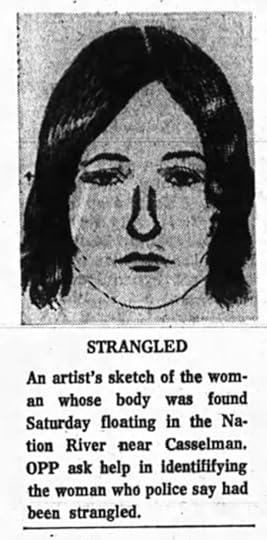 Nation River Lady composite 1
Nation River Lady composite 1Two years later, with no leads and the case of the Casselman woman still cold, police release another, more detailed sketch:
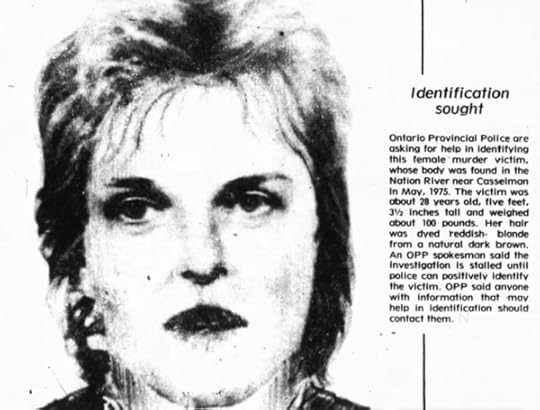 Nation River Lady composite 2
Nation River Lady composite 2In 1979, the body of a man is discovered in the Nation River about 5 miles north of Casselman. Like the Nation River Lady, the OPP say the body has been in the water for quite some time. Police later identify the man as 74-year-old George Chitouas, a resident of the Casselman Nursing Home, who regularly went for walks near the river:

Eight years after her discovery, police try to revive interest in the Casselman cold case. In a 1983 interview with the Ottawa Citizen, Inspector Carl Manneke speculates that the secret to the Nation River Lady’s identity, “is probably in Ottawa, maybe Montreal… it points that way. All the leads we came up with dead-ended in Ottawa.” Manneke elaborates that Eastern Ontario is sometimes a “dumping ground” for Montreal murders, like Windsor is for Detroit and Hamilton is for Toronto:
“What some will do to confuse police is drive the body to the Ontario side and bury it on the side of the road.”
Inspector Carl Manneke – “Police still trying o identify body from eight-year-old murder mystery”, Hugh Adami, Ottawa Citizen, January 17, 1983
Manneke then cited a case from Windsor, Ontario where the body of a prostitute from Detroit was dumped by her pimp in Canada over a drug deal dispute.
After lying in the Toronto morgue for over a decade, in 1987 the body of the Nation River Lady is finally laid to rest in plot 1654 of the city’s Mount Pleasant Cemetery. Toronto’s Chief Coroner says he needs the space for new bodies. Police reveal that the antenna wire used to strangle her was a 24-inch piece of television coaxial cable found around her neck when the body was discovered. The cable was made by a Renfrew, Ontario manufacturer for only a short period in the 1970s, and only shipped to companies in Ottawa, Hull, Brockville and Montreal.
By 1990, 15-years have passed since the Casselman slaying. A new decade brings new investigative technologies. Police release a computer-generated picture of the victim which looks quite different and younger than the two earlier hand-drawn composites, with a smaller nose and wider eyes:
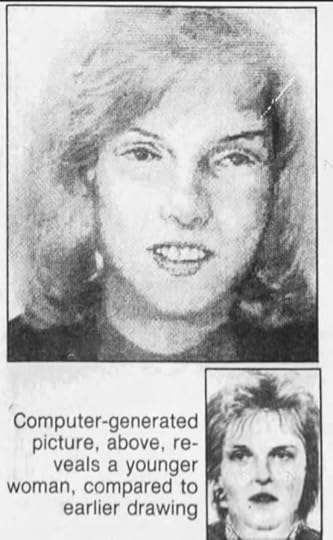 Nation River Lady computer generated picture (3)
Nation River Lady computer generated picture (3)In 1991, police release more information, practically giving away the store in hopes of identifying the Nation River Lady. Police reveal that a small piece of curtain rod was impaled under her armpit, probably from the result of a struggle. Towels were wrapped around her head, one being a distinctive tea towel from Ireland which lead investigators to believe she was English-speaking. Blood stains were found on the north side of the 417 bridge, which lead investigators to believe she was dumped off the bridge and the car was traveling east to west. The neckties used to bind her were made in Montreal and sold in Quebec and Ontario.
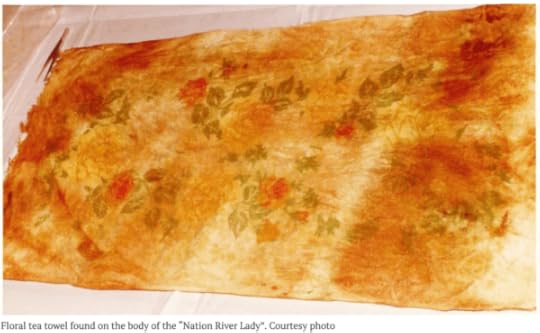
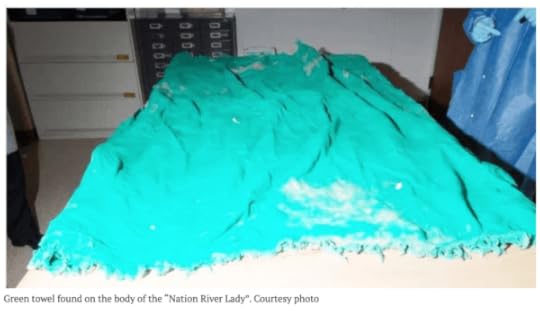
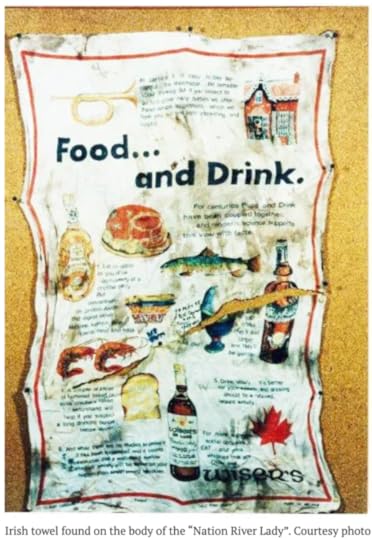
In 2010 police release another updated sketch. The OPP also invite the public to view a post-mortem photo of the victim on their cold case website. 35-years-later, the OPP now say it’s possible the body had been lying in the Nation River for as long as six months. A $50,000 reward offered by police remained uncollected.
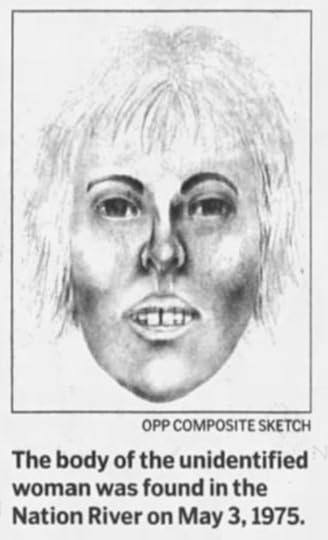 Nation River Lady computer generated picture (4)
Nation River Lady computer generated picture (4)In 2017, 42-years after the discovery, a 3-D clay bust of the woman is released thanks to new investigative and modeling technologies. The two sketch composites, two computer generated images and the 3-D bust all look completely distinct from each other – they are five different women:
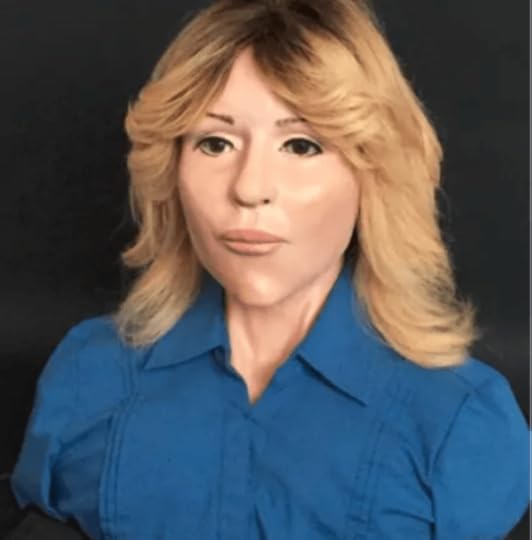 Nation River Lady 3-D model (5)
Nation River Lady 3-D model (5)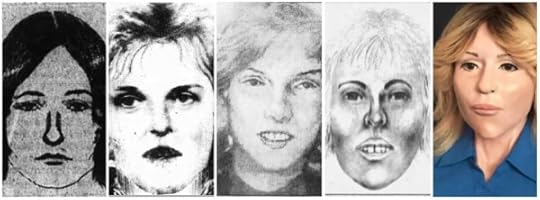 Evolution of a composite / 5 faces of the Nation River Lady – Casselman
Evolution of a composite / 5 faces of the Nation River Lady – CasselmanIn 2021 a Reddit user predicted that thanks to advances in DNA technology, the identity of the Nation River Lady (NRL) would soon be known.
“Des assassinats similaires”Most of the public information on the Nation River Lady case comes from English stories in Ontario newspapers – the Ottawa Citizen, the Ottawa Journal, The National Post. In 2017 the Journal de Montreal published a story that was never seen in English Canada. The OPP was investigating whether the Casselman slaying was related to a murder that occurred in Quebec ten days before the discovery of the Nation River Lady.
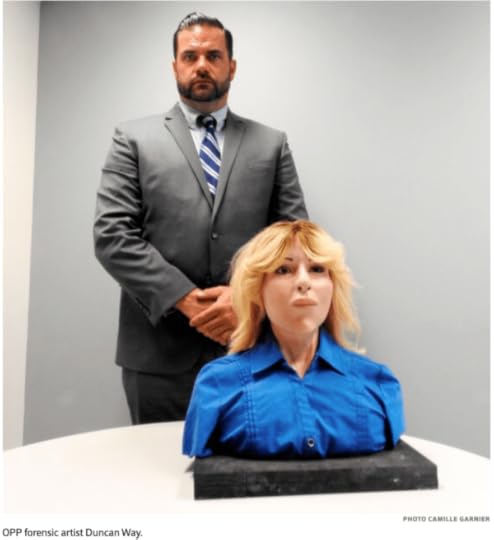
On April 22, 1975, Lise Choquette, a 30-year-old resident of Montreal was found near the construction site of the new highway in Laval, Quebec. Like the NRL, Choquette’s body was found near a bridge, in her case the Vimont viaduct which was under construction as part of the 440 Laval autoroute. Also like NRL, Choquette had been strangled, and a men’s necktie was tied tight around her neck (a grey tie with a black circles made by “Caporicci”). Choquette was found without her identification papers, and there were no obvious signs of sexual assault. Police point out that the distance between the Laval site and Casselman is only 150 kilometres.
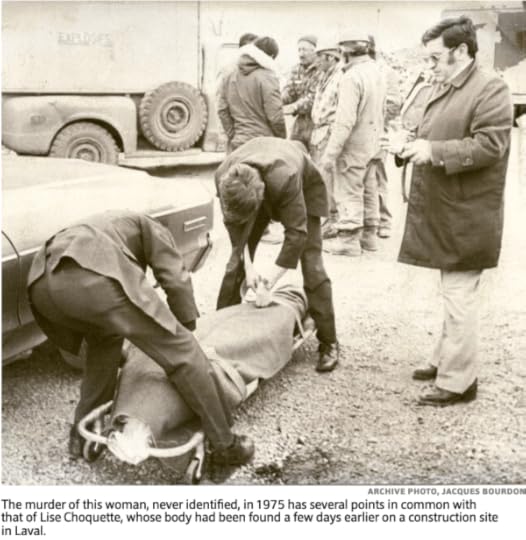 The body of Lise Choquette is removed from the construction site in Laval / 1975
The body of Lise Choquette is removed from the construction site in Laval / 1975The investigating force for the Choquette case is the Laval police, the same disinterested agency from the Marie-Ève Larivière cold case. As with Larivière, they have shown little effort to solve the Choquette case, they don’t even have a cold case unit. Laval is not even represented in the Journal de Montreal article, it is the OPP who do all the talking:
“It is true there are several striking commonalities and that the two murders took place at the same time. Investigators will surely examine the possibility of a link between these two cases.”
OPP Constable Guy Prevost – “Des assassinats similaires”, Camille Garnier, Journal de Montreal, August 2, 2017
I will say here that unlike their counterparts in Quebec, the Ontario Provincial Police worked the Nation River Lady case hard. Officers did go door to door in the surrounding area looking for answers. Hundreds of witness over many decades were interviewed. The OPP spent approximately three weeks in Trois Rivieres running down a lead. They entered NRL’s DNA into the NamUs missing persons database. They checked dental records, and national dental associations to try to identify NRL’s military made bridge plates (there is an abandoned military base, CFB Gloucester about 40 kilometres west of Casselman which closed in 1972 – giving the story an eerie Larkhill – V for Vendetta quality, put perhaps that’s for another day). By contrast, I don’t think the Laval police ever bothered to lift a fraternal brotherhood ring-finger to help solve Lise Choquette’s cold case.
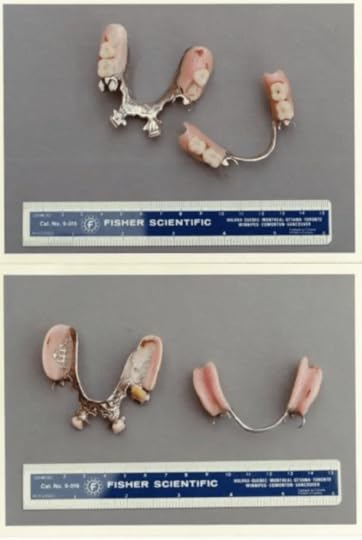 Dental plates / Nation River LadySeen And Not Seen
Dental plates / Nation River LadySeen And Not SeenI did not drive through Cornwall and Hawkesbury to avoid the traffic of Montreal. I came to visit Nation River. Because when you travel, the mind wanders.
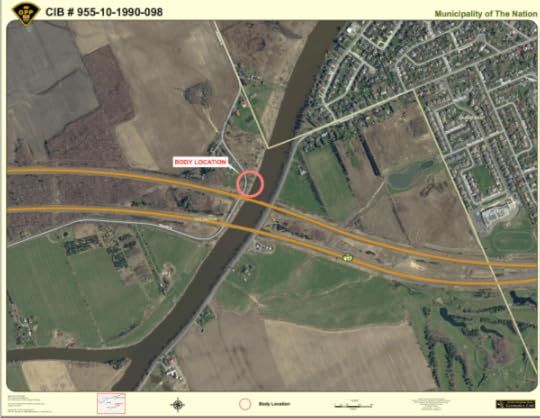 Body location / Nation River Lady
Body location / Nation River Lady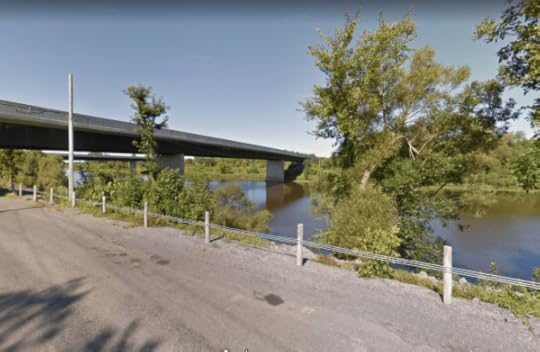 Nation River at highway 417
Nation River at highway 417And one more mystery. My mother’s people were from Winchester, Ontario, about 40 kilometres west of Casselman. There had been a tragic story handed down through her family for almost 100 years. It was said that her father – my grandfather – had caused an accidental fire that killed his younger brother. As a young boy, Mac had been smoking in the farm barn. He carelessly threw his cigarette butt on the dirt floor, and the ember ignited some hay. His brother, who had been hiding in the barn burned to death. It was said that this is what in later life caused Mac to drink, it was the source of all his troubles. It wasn’t true. The fire that killed Richard Justus occurred in 1910. Mac wasn’t born until 1917:
 Barn Fire
Barn Fire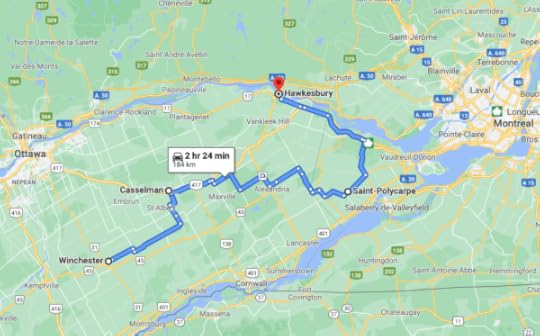 Winchester – Casselman – Saint Polycarpe – Hawkesbury
Winchester – Casselman – Saint Polycarpe – HawkesburyOne year after our initial contact I received another message from the psychic, Hannah. It read:
The post Something Fuckeried This Way Comes / WKT5 #16 first appeared on WHO KILLED THERESA?.“Your guides want you to know they are with you, helping you, and now is the time….no more think just do. I don’t know what it means but it is your sign from them. I was busy working and it hit me like someone slapped me in the back of the head.”
September 18, 2021
Riley Fairholm, shot dead by a Sûreté du Québec police officer – The Tracy Wing Interview / WKT5 #15
In July 2018, 17-year-old Riley Fairholm was shot dead by a Sûreté du Québec police officer on the deserted streets of Lac Brome. This episode is an interview with Riley’s mother, Tracy Wing. We talk about her advocacy, her lawsuit against the Quebec police, and her home town of Knowlton, real life location of the fictitious Three Pines in the Louise Penny novels featuring super Surete du Quebec investigator, Chief Inspector Armand Gamache.
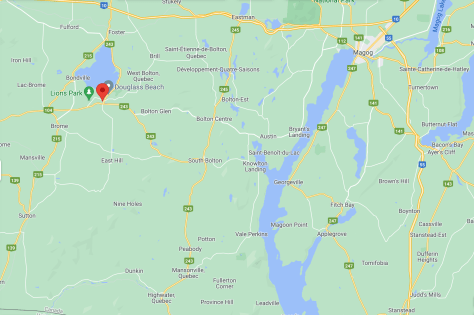 The Lac Brome / Knowlton region of Quebec’s Eastern Townships
The Lac Brome / Knowlton region of Quebec’s Eastern Townships Riley FairholmFamily of slain teen files lawsuit against SQ and officer
Riley FairholmFamily of slain teen files lawsuit against SQ and officerIn July 2018, the Sûreté du Québec responded to a 911 call about a man who was walking the streets of Lac-Brome with a weapon. Several officers arrived on the scene and within about a minute, one shot 17-year-old Riley Fairholm in the head.
Katelyn Thomas – Montreal Gazette Publishing date: July 28, 2021
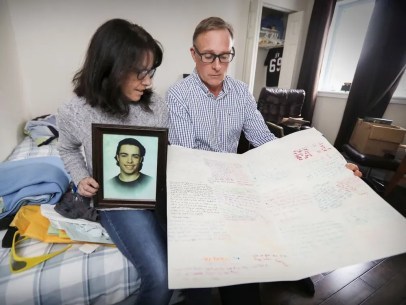 Riley Fairholm’s parents, Tracy Wing and Larry Fairholm
Riley Fairholm’s parents, Tracy Wing and Larry FairholmThree years after 17-year-old Riley Fairholm was killed by provincial police in the Eastern Townships, his family has filed a lawsuit against the force and the officer who fired the gun.
“It’s something that we feel like we have to do in order to get some accountability,” Fairholm’s mother, Tracy Wing, told the Montreal Gazette Wednesday. “I feel that the intervention was really short. They didn’t take time to negotiate, and I understand that my son was a threat — I can deal with that — but I don’t understand why they had to kill him.”
The lawsuit, filed with the Quebec Superior Court on July 13, seeks more than $700,000 in damages for Fairholm’s parents and sisters, including $100,000 in punitive damages from the officer who fired the gun. Joël Desruisseaux is named in the lawsuit as the officer in question.
Just after 1 a.m. on July 25, 2018, the Sûreté du Québec responded to a 911 call about a man who was walking the streets of Lac-Brome with a weapon. Several officers arrived on the scene and within about a minute, one shot Fairholm in the head.
“They killed my son in 60 seconds, from the minute they saw him,” Wing said. “And I believe that police officer was negligent, and it caused some damage. We’re damaged by that — all of us.”
The lawsuit states the police intervention took place in the context of a mental health crisis — Fairholm had shown signs of suicidal ideation prior to the event — and he should therefore have been handled as a vulnerable person in need of assistance. It says police should have negotiated with Fairholm and attempted to de-escalate the situation.
Police did the opposite, the lawsuit states, by not adapting their intervention to his mental state or considering that he was outside an empty business in the middle of the night.
“The attempted discussions lasted less than a minute,” the lawsuit says. “Attempts to talk only consisted of repeating the same orders over a loudspeaker.”
It also says the officers erred by not using a less powerful weapon.
“The policeman who fired used excessive and disproportionate force on a 17-year-old boy in distress,” the lawsuit says. “The police would have been able to use less force in order to carry out his arrest, or rather, and above all, to provide him with the necessary assistance.”
It wasn’t until months after Fairholm’s death that his parents learned the officer had shot him in the head. They weren’t allowed to see their son at the hospital where he had been taken after the shooting.
Wing and her ex-husband, Larry Fairholm, filed complaints against the Bureau des enquêtes indépendantes (BEI) and the SQ with the police ethics commissioner, claiming officers broke protocol and tainted the investigation into their son’s death.
In October 2019, following an investigation by the BEI, Quebec’s office of criminal prosecutions (DPCP) said officers involved in the incident had followed the law and that no charges would be laid. Since Fairholm refused to drop his weapon, the DPCP said, he “could have fired at any moment.” The lawsuit states the weapon was a pellet gun.
The Quebec coroner’s office recently announced it would hold a public inquiry into the case.
Three years after Fairholm’s death, his family is still awaiting answers. In addition to feeling grief and despair, they say they have lost confidence in police.
“There’s mistrust everywhere, in all the institutions, because it’s been so difficult to get any information — whether it’s from the prosecutor, the BEI, the SQ or even the coroner,” Wing said. “I’m very grateful that I have a public inquiry from the coroner, but you know, it’s been over three years and it’s appalling to me that it’s taking this long.”
Wing hopes the lawsuit will shed some light on the officer’s thought process.
“He didn’t shoot him in centre mass, so I’m wondering what was he taught at the police academy,” she said.
“If we do have a positive verdict in the lawsuit, that would mean that someone other than I and my family and our friends and many supporters that we have would say that, yes, there was this fault there, and it could have been better — that there’s some responsibility to be had by the SQ, because without their actions, my son would still be alive and we wouldn’t be suffering.”
The Sûreté du Québec declined to comment, “as the case is the subject of legal proceedings.”
The post Riley Fairholm, shot dead by a Sûreté du Québec police officer – The Tracy Wing Interview / WKT5 #15 first appeared on WHO KILLED THERESA?.September 4, 2021
“Some nameless scapegoat in the middle” – The Killing of David Cross / WKT5 #14
Before he died last year, my father and I had been talking about his years working at Dominion Bridge, the engineering and construction giant headquartered at the southwestern end of Montreal. He remembered he had a secretary who was from the Kahnawake reserve across the Saint Lawrence. Occasionally there’d be some kind of trouble or unrest with some of the Mohawk tribe members. Whenever that would happen she’d say, “Oh that’s just the Warriors”.
Many of those Mohawks worked construction, they were particularly skilled steel workers. My dad remembered one guy who was a foreman on jobs. They used to travel together to projects, particularly in the north around Sept-Îles. My dad would show up at the gate – in those days Wardair was at the back, in the northeast corner of Dorval Airport – and there’d be this foreman with his canoe. It would be that way with most out-of-town jobs, the canoe would travel everywhere with this Mohawk foreman. They’d load the canoe in the hull of the plane, and off they’d go.
I’ll begin with mention of something in the news this week – and, no, it’s not the body found in a suitcase, that’s not my style, though that does appear to be happening a lot lately in Juarez – the city formerly known as Toronto. It’s about the retirement this week of the suspended head of the Surete du Quebec, Martin Prud’homme. Recall that in 2018 Prud’homme testified at the Viens inquiry how he “didn’t have any information or details that led [him] to think there was a major problem in Val-d’Or” Quebec. When asked if he’d heard about how SQ officers had taken intoxicated Indigenous people on “starlight tours” Prud’homme responded that he had never heard of such a practice before.
 Former head of the Surete du Quebec, Martin Prud’homme
Former head of the Surete du Quebec, Martin Prud’hommePrud’homme was removed as director of the Sûreté du Québec in 2019 for committing a possible ethical breach related to leaks of information. His confidentiality agreement with the Quebec government allowed him to retire without making any comments. The Quebec Government was quick to double-stitch the silence by withdrawing “the request addressed to the Public Service Commission to hold an investigation and report on Mr. Martin Prud’homme Director General of the SQ .”, and thus the whole matter of possible police corruption was quietly swept sous le tapis. Fin
——————–
There are two stories I’ve been reluctant to tell of Quebec injustice. One concerns the 1989 mass murder of 14 women at the École Polytechnique de Montréal. The second is the 1990 Kanesatake Resistance, also known as the Oka Crisis. Both incidents have seen plenty of coverage, there’s volumes of work written about them. In the case of Oka, I can’t see doing a better job telling that story than what the filmmaker Alanis Obomsawin achieves in her many documentaries on the affair. And anyway, you can’t tell the story of Oka without first understanding what happened to David Cross.
This is an old story – another kick in the ribs brought to you courtesy of the Quebec Police Force. It’s going to feel very familiar and contemporary to you. It’s got all your favorite players – Jean-Claude Bernheim, that crazy-cat, Frank Shoofey, the justice minister, Marc Andre Bedard. Cops and car chases…
Early Saturday evening, October 20, 1979, 28-year-old David Cross was shot dead outside his home on the Caughnawaga (Kahnawake) Reserve on the South Shore of the St. Lawrence River near Montreal.
 David Cross and his wife Linda
David Cross and his wife LindaCross had been the subject of a high-speed police chase by the Surete du Quebec, in those days called the Quebec Police Force. According to the QPF, the police cruiser and Cross’s vehicle collided several times during the pursuit through the streets of Montreal. The chase continued across the Mercier Bridge, then onto the First Nations Reserve near Sainte Catherine, Quebec. Cross abandoned the vehicle at his home then disappeared into his house. Police constable Gervais Ouellet next handcuffed Cross’s brother, Matthew who was riding along side of him, and put him in the back of the police cruiser. Police spokesmen, Constable Robert Brunet told the public that as the cruiser was pulling out of the drive, David Cross then emerged from the home carrying a “big, black object” which others said was the end of a broomstick or pool cue. According to Lessard, Cross proceeded to smash the front windshield of the police cruiser. When Cross attempted to open the driver’s door of the cruiser, constable Robert Lessard who was seated at the wheel, opened the door, remained seated and shot David Cross three times. Several children and relatives stood by and witnessed the event.
A woman reported to have been Matthew Cross’ wife had tried to intervene. She too emerged from the house and asked the Quebec Police to leave, instructing them to contact the reserve’s own police, a 10-member force paid for by residents of the reserve known as the Peacekeepers. The Quebec police ignored her pleas, shot David Cross dead, leaving his widow and two young sons, “horribly upset by her husband’s death.”
“This is what I can’t understand. Why two six-footers, supposedly highly-trained officers who went through Nicolet ( police academy), didn’t get out of their car to apprehend one guy armed with a broomstick. If they had only waited for the peacemakers, none of this would have happened.”
Paul Deer – Peacekeepers chief of police
The 5,000- member reserve called a band council meeting, immediately deciding to attempt to have murder charges brought “against the person or persons responsible for the brutal killing.” Chief Andrew Delisle emerged from the meeting stating, “We don’t want any more provincial police on our reserve… the QPF doesn’t understand our people.” Delisle said the council would hold its own inquiry, but also called for the Quebec justice department to hold an immediate investigation into the shooting, adding that Cross’s death was the result of “bungling by the provincial and federal governments.” For years residents of Kahnawake had been demanding that the federal government pay for an organized, reserve-run force. The Canadian federal government would only agree if such a force was recognized by the province of Quebec, and Quebec would only agree if Quebec controlled it. The stalemate had lingered well past memory.
“We’re going to move on our own because we have no confidence that anybody will do anything for us anymore.”
“Any QPF officer we find on our land will be asked to leave. If the Officer doesn’t leave the reserve he will be arrested, charged with trespassing and detained – for his own protection.”
Chief Andrew Delisle
Police alleged David Cross had been speeding. But the QPF had a track record of running down members of the reserve and roughing them up. In an incident over the summer, police chased an Indian onto the Mercier Bridge, shot at him five times, before handcuffing him and his friends to the bridge. Cross had claimed he had been beaten several times by Quebec police. When they decided to chase you, the natural instinct was to run.
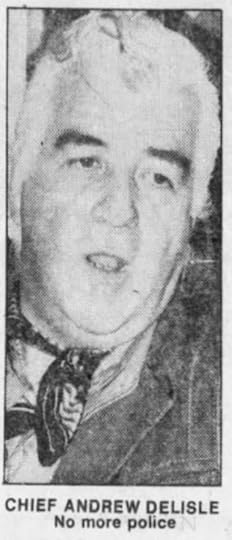
By mid-week Premier Rene Levesque ordered a coroner’s inquest into the matter, but stopped short of the requested inquiry into QPF-Indian relations saying Cross’s death was an isolated incident and did not reflect “generally peaceful relations with Indians in Quebec” ( First Nations would have to wait another 40 years for a full inquiry, and even today we are waiting for the government to make good on the recommendations of both the Truth and Reconciliation and Viens inquiries). Matters weren’t helped when on the morning of Tuesday, October 23, three women from the reserve were arrested for beating two Montreal taxi cab drivers with a crowbar and a baseball bat, setting one of their cabs on fire. The other cab was stolen, and driven across the Mercier Bridge into Kahnawake, apparently in an attempt to lure the QPF onto the reserve to exact revenge. Instead they engaged the Montreal police force, who chased the taxi cab for three miles across reserve dirt roads. When they reached a dead end, the police cruiser was blocked by a car with Michigan state license plates. A man emerged from the vehicle with a rifle who police mistook for a Peacekeeper until he told the officers, “You better fuck off or we will kill you!” Paul Deer, police chief of the reserve’s Peacemakers said of the incident, “there may be a tie-in” because of tensions. In response, the QPF ordered its officers not to enter the reserve under any circumstance.
On Wednesday, October 24, Mohawks buried 28-year-old David Cross in the rain in the reserve’s cemetery. 1,000 mourners attended the funeral where Cross was given ancient final rights by the band’s tribal chief, Joseph Phillips, Cross’s widow and two young boys standing graveside. Cross was eulogized for being a great hunter and high-steel worker. He was accustomed to traveling to the United States to do structural steel work. Often his wife, Linda would accompany him on these trips.
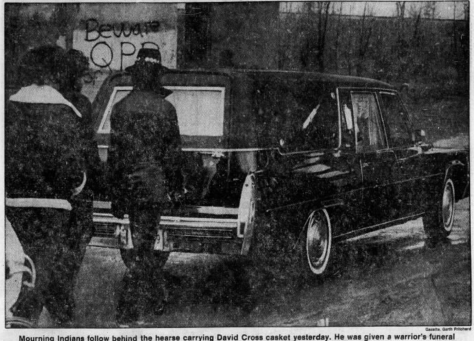
For years Mohawk members had complained about service calls by the RCMP and QPF to the reserve. According to Chief Andrew Delisle, “They were just too slow, we’d call them about something and they’d arrive a couple of hours later.” In 1969, after much lobbying, the Mohawks were given permission to form their own police force. The Peacekeepers were given the same functions as an urban force such as the Montreal police, but it was an early and very ancient experiment in community policing, operating according to Mohawk traditions. At the core, the Peacekeeper’s role was to keep human beings from harming each other.
“The peacekeepers have no hesitation about going to people, sitting down and talking to them about what they’ve done. We don’t raid people’s homes. We knock on their door and ask them to come in.”
Andrew Delisle
The Kahnawake reserve started as a 20,000 acre tract awarded to the Mohawks in 1762 in gratitude for assisting the English in the war with the French. Over two hundred years the land had been whittled back to 12,500 acres as Canadians needed land for bridges, railways and seaways. Often this came in exchange for jobs, like steel work. But you’d be pissed too if someone constantly kept gnawing away at what was yours.
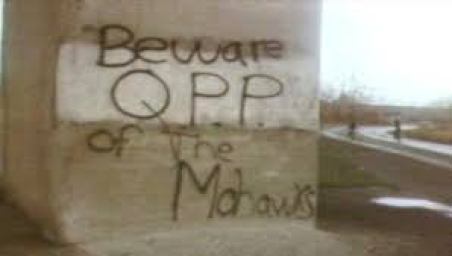 “Beware QPP of The Mohawks”
“Beware QPP of The Mohawks”By November 1979 talks were underway for the coroner’s investigation ordered by Quebec Justice Minister Marc Andre Bedard. The Caughnawaga Band Council insisted the inquiry be held on Mohawk land, the QPF maintained it should be conducted where coroner’s inquiries are always held, at their headquarters at 1701 rue Parthenais. Further delays were anticipated when Quebec Civil Servants – which included court clerks – threatened a general strike later in the month. Jean-Claude Bernheim of the Quebec Civil Liberties Union urged the justice minister to “keep the QPF out of the Cross inquiry” after it was revealed the QPF officer Marcel Lacoste – himself a player in the Richard Blass affair in which the Montreal gangster was shot 27 times by police – would be permitted to investigate the shooting on behalf of the inquest:
The choice of Lacoste as an inquirer into the Cross affair is unjudicious given that this same policeman was implicated directly in the event which led to the death of Richard Blass, Jan. 24, 1975.”
Jean-Claude Bernheim
The situation only worsened when on November 9, Fernand Giroux, one of the cabbies attacked in the retaliation incident, died in the Royal Victoria hospital as a result of his wounds. 400 taxi drivers attended Giroux’s funeral in LaSalle, passing the collection plate for his family. Father Leon Lajoie asked for forgiveness and urged the gathering to pardon those who didn’t know what they were doing. Three young women were being detained for the murder of Giroux.
At the coroner’s inquest, QPF constable Robert Lessard testified, “At no time did I want to kill that man.” Lessard stated the car pursuit began when Cross’s Chrysler passed the Ville St. Pierre interchange near LaSalle. His partner, Gervais Ouellet put on his flashers and siren and managed to pull alongside the vehicle as it crossed the Mercier Bridge, at times at speeds of 140 kilometers an hour in a 70 kilometer zone. Lessard rammed Cross’ Chrysler several times – almost forcing them into oncoming traffic – but was unable to slow the vehicle.
“The driver of the vehicle gave him the “finger” and shook his head indicating he had no intention of stopping.” Lessard testified that he shot Cross – twice in the stomach, once in the chest – when Cross opened the cruiser door and lunged at “my face”, though there had also been testimony that Lessard failed to warn the victim before firing his weapon. Nine witnesses also testified that Cross made no attempt to open the driver’s side door of the police vehicle. The shots were fired in rapid succession with one witness exclaiming, “The dirty bastards shot David.” Lessard then exited the vehicle, waving his gun in front of women and children and shouted, “You’re a bunch of crazy people.” Matthew Cross testified that his brother was simply trying to get him out of the back seat of the police car. As David Cross lay dying in the mud, Lessard called for backup rather than an ambulance.
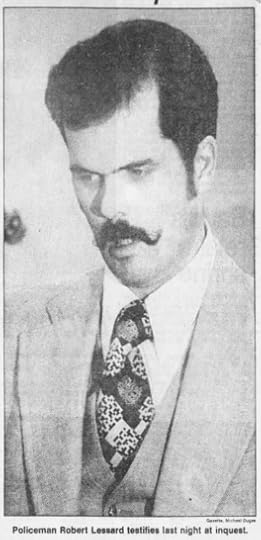 QPF constable Robert Lessard
QPF constable Robert LessardOn January 3, 1980, Quebec Coroner Cyrille Delage ruled that Quebec Police Force constable Robert Lessard was criminally responsible for the death of David Cross, calling Lessard’s actions an “abusive use of force… negligent, unskillful and acting without thinking.” David’s widow, Linda Cross said “It’s no victory for us yet. Victory will come when the person who killed (David) is jailed.” In the months that followed the October 20 shooting constables Lessard and Ouellet had continued to work for the Quebec Police Force, though the public had been lead to believe they were assigned to desk jobs. Cross family attorney, Frank Shoofey said he was surprised by the coroner’s decision because, “usually in all these cases the police are given the benefit of the doubt.”
Almost immediately, Quebec’s attorney-general charged constable Lessard with manslaughter for the shooting death of Cross. The news made the front page of the Saturday Gazette, but was overshadowed by the headline, “CLAUDE RYAN: THE PREMIER IN WAITING”, foretelling the almost certainty that the former director of Quebec’s Le Devoir newspaper and Liberal party member would become the next leader of Quebec. It was not to be as Rene Levesque’s Parti Quebecois won a second term in power. But the Liberals would live again with the second coming of Robert Bourassa, and Ryan serving as his Minister of Public Security during Bourassa’s fourth and final term a decade later, notably during the Oka Crisis.
By mid-week the director of the Quebec Police Force was upset by an “avalanche of insults” being hurled at his officers in the French press. Setting the bar at a limbo-low, Jacques Beaudoin argued,
“Our police force has 110 years of experience… and all administrations down through our history have had difficulties with the Indians. We certainly don’t believe our methods are error-free but they are certainly no worse than those in the rest of Canada and in the United States.”
QPF Director Jacques Beaudoin
On January 25, 1980 constable Robert Lessard pleaded not guilty to the charge of manslaughter. A preliminary hearing was set for the spring. Over the course of those months, where the public had been lead to believe Lessard was confined to desk duty, it came to light that he and his partner, Gervais Ouellet had been working patrol for the QPF. When the Mohawks complained to Quebec Justice Minister Marc-Andre Bedard, he claimed that he too had been “mislead”. QPF director Jacques Beaudoin joined the acting claiming he had been similarly mislead, and a subordinate officer would be disciplined. The Mohawks were having none of it:
“Nobody will accept any responsibility for what’s happened. Bedard says it’s not his fault. Beaudoin says it’s not his fault and they’re blaming some nameless scapegoat in the middle.”
Peter Dionne – editor, Indians of Quebec
That Lessard was out on police patrol was one of the worst kept secrets in the province. On December 14, 1979, Daniel Gignac of CHOM-FM, one of the most popular English radio stations in Montreal, was arrested by constables Lessard and Ouellet for drunk-driving. Gignac even complained at the time that Lessard had physically assaulted him – remember this would have been less than two months since Cross’ shooting, an event the coroner described as an “abusive use of force… negligent, unskillful and acting without thinking.” Linda Cross’s mother lamented, “We’ve been had again.” In court for the drunk-driving charge, Gignac testified that Lessard had knocked him to the ground and put him in handcuffs. The judge concluded it had been Gignac who was abusive, finding him guilty of resisting arrest for refusing to take a breathalyzer test.
“This whole thing has become a charade. It’s a mockery of justice… We’ve been shafted. As long as we have to work within this system we’re going to continue getting shafted.”
Indians of Quebec editor, Peter Dionne
Lessard’s preliminary hearing was closed to the public at the request of the constable’s lawyer, Michel Proulx. Judge Luc Trudel finally decided that the case warranted that Lessard stand trial for the charge of manslaughter.
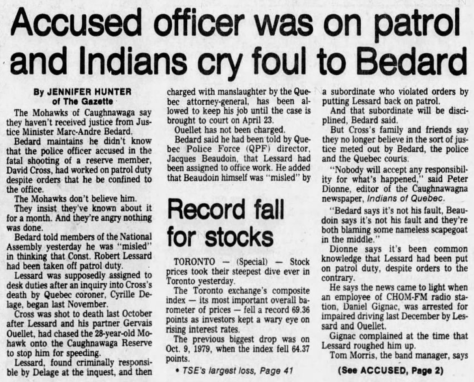
Approaching the one year anniversary of David Cross’s shooting death, Linda Cross filed a $264,500 damage action law suit against the Quebec government and constables Ouellet and Lessard charging they were “jointly and severally” responsible for the death of her husband. Specifically the suit argued that Lessard used “grossly excessive force” and acted in a totally “incompetent and unreasonable manner”, while Ouellet had “done nothing to attempt the orderly and peaceful arrest” of the victim.
At the trial held in November 1980, most of the testimony was the same or similar to what was heard at the coroner inquiry a year earlier. A witness testified that neither officer seemed in a particular hurry to check on Cross’s condition after Lessard shot him. A 15-year-old boy told the court Cross was unarmed when he was shot, “David put his hands up to protect his face just before the shots were fired.”
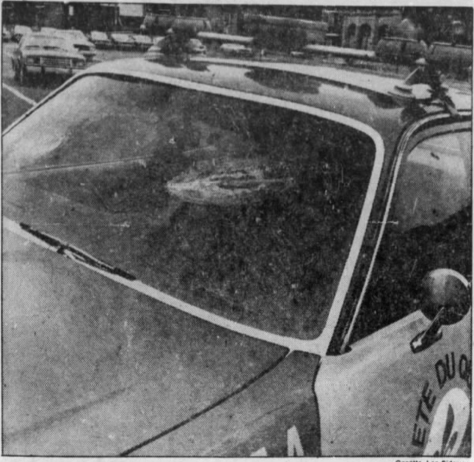 Surete du Quebec police cruiser with shattered glass
Surete du Quebec police cruiser with shattered glassLessard told the court that he “feared for his life”. “Glass was falling all over me” he dramatically told the court. It’s clear from photos that the squad car’s windshield was shattered and cracked, not broken. When asked why he hadn’t aimed for Cross’s arms or legs Lessard defended, “Everything was just happening too fast.” The Quebec Superior Court jury found Robert Lessard not guilty of the shooting death of David Cross. Lessard wept at the reading of the verdict, later telling the media:
“I want to stay on the force. I still want to be a policeman and serve the public. I just hope that this is the end of the nightmare.”
The Mohawks assured the public that there would be no reprisals. At the same time, the Kahnawake band council threatened to erect toll booths on highways passing through their reserve to raise money they argued that was owned to them by the federal government. A spokesman for the QPF made a statement that, “We have nothing more to say about [it]. The matter is finished, dead and buried as far as we’re concerned.”
Constable Lessard claimed innocence until the end, with all the major forces of Quebec public safety backing him up. By contrast, the three young Kahnawake women charged with manslaughter for the killing of that Montreal taxi-diver – which can be interpreted as a protest action in response to the Cross killing – pleaded guilty, and were sentenced to jail terms ranging from four to seven years.
Four years later Matthew Cross sued officers Lessard and Ouellet arguing that his “arrest, detention, and treatment was illegal and unjustified and constituted an abuse of power”. A judge ultimately ruled that the QPF constables – by 1984 referred to as Surete du Quebec officers – were blameless, but not the detention centre officials at Parthenais. Matthew Cross was awarded$3,000 in compensation for his troubles. In the summer of 1989 Michel Proulx, the lawyer who had defended constable Robert Lessard, was sworn in as a judge to the Quebec Court of Appeal.
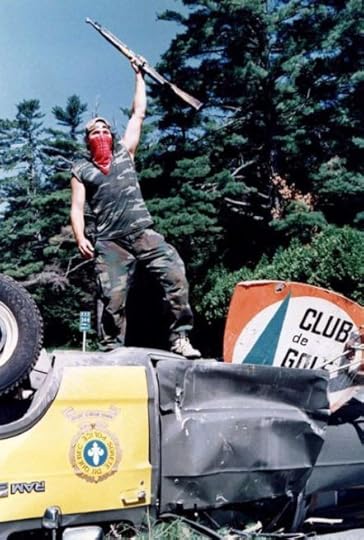 1990 Kanesatake Resistance
1990 Kanesatake ResistanceFor nearly a decade police did not openly enter the Kahnawake reserve land. Then in December 1989, reserve members charged that undercover Surete du Quebec officers infiltrated a Kahnawake high stakes bingo hall preparing for the arrest of a busload of departing participants. The following summer the Oka Crisis – The Resistance – would unfold on neighboring Kanesatake territory. The standoff between Mohawk Warriors, and the Canadian Armed Forces, RCMP and Surete du Quebec lasted 78 days and began when the town of Oka tried to expand a municipal golf course into a Mohawk burial ground and other sacred land known as The Pines. The Canadian government eventually ruled that the “conflict was rooted in a centuries old land dispute and fueled by racism.” One Mohawk elder and one Surete du Quebec officer lost their lives. To this day no one knows for sure who lit the match, who gave the order to deploy Surete du Quebec police to Mohawk land – was it SQ director, Robert Lavigne, or minister of public security, Claude Ryan, or the premier himself, Robert Bourassa?
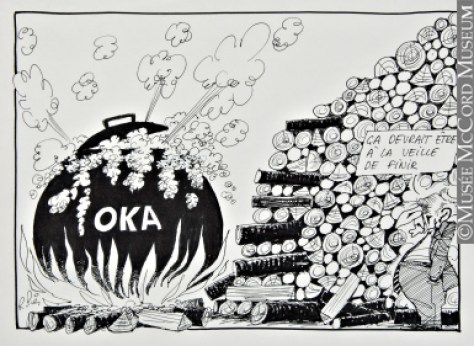
In the 1990s Robert Lessard appears to have continued to work for Quebec law enforcement. In the spring of 1991, a Robert Lessard was investigating a robbery of $90,000 worth of computer equipment from a West Island manufacturing company on behalf of the Montreal police force. Later that summer that same Robert Lessard helped break up a heroin deal in St. Laurent and an extortion scam at a shopping mall in Cote Vertu.
——————————
The Covid health crisis has erased much of our pre-2020 memory. You may recall just prior to lockdown in March of 2020, a railway blockade southwest of Montreal done in conjunction with the Wet’suet’en protest, a solidarity movement against the construction of an oil pipeline in British Columbia. Similar to the 1990 blockade of the Mercier bridge, Kahnawake protesters blocked freight and commuter trains trying to cross their territory. By late February, the blockade had gone on for three weeks, frustrations were mounting, and this time, the matter was in the hands of the Kahnawake Peacekeepers.

By the 1990s the Peacekeepers had become fully funded by the federal and provincial governments, each providing approximately 50 percent of the 33-person force’s $4.5 million annual operating budget. Under an agreement with the Quebec government, “the Surete du Quebec and the Peacekeepers must take the necessary steps to ensure mutual assistance and co-operation with respect to the effective monitoring of compliance with applicable legislation.” This was not the first attempt at cooperation between the SQ and the Mohawks. In 2012 the Mohawk Council of Kahnawake asked the Quebec public security ministry for help establishing a SWAT team – made up exclusively of Mohawk Peacekeepers, but trained by Sûreté du Québec experts – to help fight organized crime.
For over 40 years – ever since the shooting of David Cross – the SQ has been barred from entering Kahnawake. Despite mounting public tensions, no one expected the Quebec police to intervene to disrupt the rail blockade unless instructed to by the Peacekeepers. Even the Premier, Francois Legault – who wanted the police to intervene – did not have the power to make that happen. Give Legault credit for at the least being transparent about his intentions.
 David Cross
David CrossIn March 2020 the Kahnawake blockade ended peacefully. In a prepared statement, Mohawk film director, Roxann Whitebean commented,
“Let this be a strong message and demonstration of good faith to all of Canada, we prefer a peaceful resolution and demand that Indigenous Peoples’ rights be respected.”
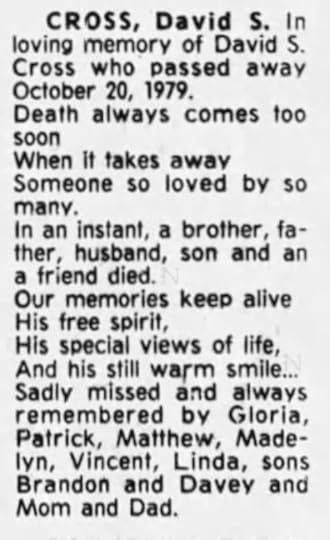 David Cross memory obituary – October 20, 1984
David Cross memory obituary – October 20, 19841979 must have been some kind of year for Minister of Justice Marc-Andre Bedard. He was under attack. He was on his heels. In July there were the murders of Chantal Dupont and Maurice Marcil, thrown from the Jacques Cartier Bridge. You had Jacques Déry – the father of 13-year-old Diane Déry, murdered in 1975 – petitioning Bedard to transfer the case from Longueuil to the SQ. The Allo Police headlines were screaming “228 RAPES” in the province, year-to-date. Nicole Gaudreault was murdered that summer in Montreal. Edmond Turcotte was back in court concerning the 1975 murder of Diane Thibeault. Then just when it appeared things were settling down, along comes this constable, this reckless fool who shoots a Mohawk, then later has the nerve to tell the public he’d like to remain in law enforcement. And of course the prelude to these events was the discovery in the spring of 1979 of the body of Theresa Allore. Police I suspect hoped since her disappearance the prior year that she would turn up as a runaway, but SQ Inspector Roch Gaudreault anticipated the tragedy when he predicted her body would eventually be discovered after the snow melted. This completed the trilogy of murders in that era, and evidenced the possibility that a serial murderer had stalked the Eastern Townships. By 1979 serial murder, it seemed, was on the decline in Quebec. But what did not change was a consistency of incompetence from all the components of the Quebec justice system.
The post first appeared on WHO KILLED THERESA?.“Some nameless scapegoat in the middle” – David Cross / WKT5 #14
Before he died last year, my father and I had been talking about his years working at Dominion Bridge, the engineering and construction giant headquartered at the southwestern end of Montreal. He remembered he had a secretary who was from the Kahnawake reserve across the Saint Lawrence. Occasionally there’d be some kind of trouble or unrest with some of the Mohawk tribe members. Whenever that would happen she’d say, “Oh that’s just the Warriors”.
Many of those Mohawks worked construction, they were particularly skilled steel workers. My dad remembered one guy who was a foreman on jobs. They used to travel together to projects, particularly in the north around Sept-Îles. My dad would show up at the gate – in those days Wardair was at the back, in the northeast corner of Dorval Airport – and there’d be this foreman with his canoe. It would be that way with most out-of-town jobs, the canoe would travel everywhere with this Mohawk foreman. They’d load the canoe in the hull of the plane, and off they’d go.
I’ll begin with mention of something in the news this week – and, no, it’s not the body found in a suitcase, that’s not my style, though that does appear to be happening a lot lately in the Toronto area. It’s about the retirement this week of the suspended head of the Surete du Quebec, Martin Prud’homme. Recall that in 2018 Prud’homme testified at the Viens inquiry how he “didn’t have any information or details that led [him] to think there was a major problem in Val-d’Or” Quebec. When asked if he’d heard about how SQ officers had taken intoxicated Indigenous people on “starlight tours” Prud’homme responded that he had never heard of such a practice before.
 Former head of the Surete du Quebec, Martin Prud’homme
Former head of the Surete du Quebec, Martin Prud’hommePrud’homme was removed as director of the Sûreté du Québec in 2019 for committing a possible ethical breach related to leaks of information. His confidentiality agreement with the Quebec government allowed him to retire without making any comments. The Quebec Government was quick to double-stitch the silence by withdrawing “the request addressed to the Public Service Commission to hold an investigation and report on Mr. Martin Prud’homme Director General of the SQ .”, and thus the whole matter of possible police corruption was quietly swept sous le tapis. Fin
——————–
There are two stories I’ve been reluctant to tell of Quebec injustice. One concerns the 1989 mass murder of 14 women at the École Polytechnique de Montréal. The second is the 1990 Kanesatake Resistance, also known as the Oka Crisis. Both incidents have seen plenty of coverage, there’s volumes of work written about them. In the case of Oka, I can’t see doing a better job telling that story than what the filmmaker Alanis Obomsawin achieves in her many documentaries on the affair. And anyway, you can’t tell the story of Oka without first understanding what happened to David Cross.
This is an old story – another kick in the ribs brought to you courtesy of the Quebec Police Force. It’s going to feel very familiar and contemporary to you. It’s got all your favorite players – Jean-Claude Bernheim, that crazy-cat, Frank Shoofey, the justice minister, Marc Andre Bedard. Cops and car chases…
Early Saturday evening, October 20, 1979, 28-year-old David Cross was shot dead outside his home on the Caughnawaga (Kahnawake) Reserve on the South Shore of the St. Lawrence River near Montreal.
 David Cross and his wife Linda
David Cross and his wife LindaCross had been the subject of a high-speed police chase by the Surete du Quebec, in those days called the Quebec Police Force. According to the QPF, the police cruiser and Cross’s vehicle collided several times during the pursuit through the streets of Montreal. The chase continued across the Mercier Bridge, then onto the First Nations Reserve near Sainte Catherine, Quebec. Cross abandoned the vehicle at his home then disappeared into his house. Police constable Gervais Ouellet next handcuffed Cross’s brother, Matthew who was riding along side of him, and put him in the back of the police cruiser. Police spokesmen, Constable Robert Brunet told the public that as the cruiser was pulling out of the drive, David Cross then emerged from the home carrying a “big, black object” which others said was the end of a broomstick or pool cue. According to Lessard, Cross proceeded to smash the front windshield of the police cruiser. When Cross attempted to open the driver’s door of the cruiser, constable Robert Lessard who was seated at the wheel, opened the door, remained seated and shot David Cross three times. Several children and relatives stood by and witnessed the event.
Matthew Cross’ wife had tried to intervene. She too emerged from the house and asked the Quebec Police to leave, instructing them to contact the reserve’s own police, a 10-member force paid for by residents of the reserve known as the Peacekeepers. The Quebec police ignored her pleas, shot David Cross dead, leaving his widow and two young sons, “horribly upset by her husband’s death.”
“This is what I can’t understand. Why two six-footers, supposedly highly-trained officers who went through Nicolet ( police academy), didn’t get out of their car to apprehend one guy armed with a broomstick. If they had only waited for the peacemakers, none of this would have happened.”
Paul Deer – Peacekeepers chief of police
The 5,000- member reserve called a band council meeting, immediately deciding to attempt to have murder charges brought “against the person or persons responsible for the brutal killing.” Chief Andrew Delisle emerged from the meeting stating, “We don’t want any more provincial police on our reserve… the QPF doesn’t understand our people.” Delisle said the council would hold its own inquiry, but also called for the Quebec justice department to hold an immediate investigation into the shooting, adding that Cross’s death was the result of “bungling by the provincial and federal governments.” For years residents of Kahnawake had been demanding that the federal government pay for an organized, reserve-run force. The Canadian federal government would only agree if such a force was recognized by the province of Quebec, and Quebec would only agree if Quebec controlled it. The stalemate had lingered well past memory.
“We’re going to move on our own because we have no confidence that anybody will do anything for us anymore.”
“Any QPF officer we find on our land will be asked to leave. If the Officer doesn’t leave the reserve he will be arrested, charged with trespassing and detained – for his own protection.”
Chief Andrew Delisle
Police alleged David Cross had been speeding. But the QPF had a track record of running down members of the reserve and roughing them up. In an incident over the summer, police chased an Indian onto the Mercier Bridge, shot at him five times, before handcuffing him and his friends to the bridge. Cross had claimed he had been beaten several times by Quebec police. When they decided to chase you, the natural instinct was to run.

By mid-week Premier Rene Levesque ordered a coroner’s inquest into the matter, but stopped short of the requested inquiry into QPF-Indian relations saying Cross’s death was an isolated incident and did not reflect “generally peaceful relations with Indians in Quebec” ( First Nations would have to wait another 40 years for a full inquiry, and even today we are waiting for the government to make good on the recommendations of both the Truth and Reconciliation and Viens inquiries). Matters weren’t helped when on the morning of Tuesday, October 23, three women from the reserve were arrested for beating two Montreal taxi cab drivers with a crowbar and a baseball bat, setting one of their cabs on fire. The other cab was stolen, and driven across the Mercier Bridge into Kahnawake, apparently in an attempt to lure the QPF onto the reserve to exact revenge. Instead they engaged the Montreal police force, who chased the taxi cab for three miles across reserve dirt roads. When they reached a dead end, the police cruiser was blocked by a car with Michigan state license plates. A man emerged from the vehicle with a rifle who police mistook for a Peacekeeper until he told the officers, “You better fuck off or we will kill you!” Paul Deer, police chief of the reserve’s Peacemakers said of the incident, “there may be a tie-in” because of tensions. In response, the QPF ordered its officers not to enter the reserve under any circumstance.
On Wednesday, October 24, Mohawks buried 28-year-old David Cross in the rain in the reserve’s cemetery. 1,000 mourners attended the funeral where Cross was given ancient final rights by the band’s tribal chief, Joseph Phillips, Cross’s widow and two young boys standing graveside. Cross was eulogized for being a great hunter and high-steel worker. He was accustomed to traveling to the United States to do structural steel work. Often his wife, Linda would accompany him on these trips.

For years Mohawk members had complained about service calls by the RCMP and QPF to the reserve. According to Chief Andrew Delisle, “They were just too slow, we’d call them about something and they’d arrive a couple of hours later.” In 1969, after much lobbying, the Mohawks were given permission to form their own police force. The Peacekeepers were given the same functions as an urban force such as the Montreal police, but it was an early and very ancient experiment in community policing, operating according to Mohawk traditions. At the core, the Peacekeeper’s role was to keep human beings from harming each other.
“The peacekeepers have no hesitation about going to people, sitting down and talking to them about what they’ve done. We don’t raid people’s homes. We knock on their door and ask them to come in.”
Andrew Delisle
The Kahnawake reserve started as a 20,000 acre tract awarded to the Mohawks in 1762 in gratitude for assisting the English in the war with the French. Over two hundred years the land had been whittled back to 12,500 acres as Canadians needed land for bridges, railways and seaways. Often this came in exchange for jobs, like steel work. But you’d be pissed too if someone constantly kept gnawing away at what was yours.
 “Beware QPP of The Mohawks”
“Beware QPP of The Mohawks”By November 1979 talks were underway for the coroner’s investigation ordered by Quebec Justice Minister Marc Andre Bedard. The Caughnawaga Band Council insisted the inquiry be held on Mohawk land, the QPF maintained it should be conducted where coroner’s inquiries are always held, at their headquarters at 1701 rue Parthenais. Further delays were anticipated when Quebec Civil Servants – which included court clerks – threatened a general strike later in the month. Jean-Claude Bernheim of the Quebec Civil Liberties Union urged the justice minister to “keep the QPF out of the Cross inquiry” after it was revealed the QPF officer Marcel Lacoste – himself a player in the Richard Blass affair in which the Montreal gangster was shot 27 times by police – would be permitted to investigate the shooting on behalf of the inquest:
The choice of Lacoste as an inquirer into the Cross affair is unjudicious given that this same policeman was implicated directly in the event which led to the death of Richard Blass, Jan. 24, 1975.”
Jean-Claude Bernheim
The situation only worsened when on November 9, Fernand Giroux, one of the cabbies attacked in the retaliation incident, died in the Royal Victoria hospital as a result of his wounds. 400 taxi drivers attended Giroux’s funeral in LaSalle, passing the collection plate for his family. Father Leon Lajoie asked for forgiveness and urged the gathering to pardon those who didn’t know what they were doing. Three young women were being detained for the murder of Giroux.
At the coroner’s inquest, QPF constable Robert Lessard testified, “At no time did I want to kill that man.” Lessard stated the car pursuit began when Cross’s Chrysler passed the Ville St. Pierre interchange near LaSalle. His partner, Gervais Ouellet put on his flashers and siren and managed to pull alongside the vehicle as it crossed the Mercier Bridge, at times at speeds of 140 kilometers an hour in a 70 kilometer zone. Lessard rammed Cross’ Chrysler several times – almost forcing them into oncoming traffic – but was unable to slow the vehicle.
“The driver of the vehicle gave him the “finger” and shook his head indicating he had no intention of stopping.” Lessard testified that he shot Cross – twice in the stomach, once in the chest – when Cross opened the cruiser door and lunged at “my face”, though there had also been testimony that Lessard failed to warn the victim before firing his weapon. Nine witnesses also testified that Cross made no attempt to open the driver’s side door of the police vehicle. The shots were fired in rapid succession with one witness exclaiming, “The dirty bastards shot David.” Lessard then exited the vehicle, waving his gun in front of women and children and shouted, “You’re a bunch of crazy people.” Matthew Cross testified that his brother was simply trying to get him out of the back seat of the police car. As David Cross lay dying in the mud, Lessard called for backup rather than an ambulance.
 QPF constable Robert Lessard
QPF constable Robert LessardOn January 3, 1980, Quebec Coroner Cyrille Delage ruled that Quebec Police Force constable Robert Lessard was criminally responsible for the death of David Cross, calling Lessard’s actions an “abusive use of force… negligent, unskillful and acting without thinking.” David’s widow, Linda Cross said “It’s no victory for us yet. Victory will come when the person who killed (David) is jailed.” In the months that followed the October 20 shooting constables Lessard and Ouellet had continued to work for the Quebec Police Force, though the public had been lead to believe they were assigned to desk jobs. Cross family attorney, Frank Shoofey said he was surprised by the coroner’s decision because, “usually in all these cases the police are given the benefit of the doubt.”
Almost immediately, Quebec’s attorney-general charged constable Lessard with manslaughter for the shooting death of Cross. The news made the front page of the Saturday Gazette, but was overshadowed by the headline, “CLAUDE RYAN: THE PREMIER IN WAITING”, foretelling the almost certainty that the former director of Quebec’s Le Devoir newspaper and Liberal party member would become the next leader of Quebec. It was not to be as Rene Levesque’s Parti Quebecois won a second term in power. But the Liberals would live again with the second coming of Robert Bourassa, and Ryan serving as his Minister of Public Security during Bourassa’s fourth and final term a decade later, notably during the Oka Crisis.
By mid-week the director of the Quebec Police Force was upset by an “avalanche of insults” being hurled at his officers in the French press. Setting the bar at a limbo-low, Jacques Beaudoin argued,
“Our police force has 110 years of experience… and all administrations down through our history have had difficulties with the Indians. We certainly don’t believe our methods are error-free but they are certainly no worse than those in the rest of Canada and in the United States.”
QPF Director Jacques Beaudoin
On January 25, 1980 constable Robert Lessard pleaded not guilty to the charge of manslaughter. A preliminary hearing was set for the spring. Over the course of those months, where the public had been lead to believe Lessard was confined to desk duty, it came to light that he and his partner, Gervais Ouellet had been working patrol for the QPF. When the Mohawks complained to Quebec Justice Minister Marc-Andre Bedard, he claimed that he too had been “mislead”. QPF director Jacques Beaudoin joined the acting claiming he had been similarly mislead, and a subordinate officer would be disciplined. The Mohawks were having none of it:
“Nobody will accept any responsibility for what’s happened. Bedard says it’s not his fault. Beaudoin says it’s not his fault and they’re blaming some nameless scapegoat in the middle.”
Peter Dionne – editor, Indians of Quebec
That Lessard was out on police patrol was one of the worst kept secrets in the province. On December 14, 1979, Daniel Gignac of CHOM-FM, one of the most popular English radio stations in Montreal, was arrested by constables Lessard and Ouellet for drunk-driving. Gignac even complained at the time that Lessard had physically assaulted him – remember this would have been less than two months since Cross’ shooting, an event the coroner described as an “abusive use of force… negligent, unskillful and acting without thinking.” Linda Cross’s mother lamented, “We’ve been had again.” In court for the drunk-driving charge, Gignac testified that Lessard had knocked him to the ground and put him in handcuffs. The judge concluded it had been Gignac who was abusive, finding him guilty of resisting arrest for refusing to take a breathalyzer test.
“This whole thing has become a charade. It’s a mockery of justice… We’ve been shafted. As long as we have to work within this system we’re going to continue getting shafted.”
Indians of Quebec editor, Peter Dionne
Lessard’s preliminary hearing was closed to the public at the request of the constable’s lawyer, Michel Proulx. Judge Luc Trudel finally decided that the case warranted that Lessard stand trial for the charge of manslaughter.

Approaching the one year anniversary of David Cross’s shooting death, Linda Cross filed a $264,500 damage action law suit against the Quebec government and constables Ouellet and Lessard charging they were “jointly and severally” responsible for the death of her husband. Specifically the suit argued that Lessard used “grossly excessive force” and acted in a totally “incompetent and unreasonable manner”, while Ouellet had “done nothing to attempt the orderly and peaceful arrest” of the victim.
At the trial held in November 1980, most of the testimony was the same or similar to what was heard at the coroner inquiry a year earlier. A witness testified that neither officer seemed in a particular hurry to check on Cross’s condition after Lessard shot him. A 15-year-old boy told the court Cross was unarmed when he was shot, “David put his hands up to protect his face just before the shots were fired.”
 Surete du Quebec police cruiser with shattered glass
Surete du Quebec police cruiser with shattered glassLessard told the court that he “feared for his life”. “Glass was falling all over me” he dramatically told the court. It’s clear from photos that the squad car’s windshield was shattered and cracked, not broken. When asked why he hadn’t aimed for Cross’s arms or legs Lessard defended, “Everything was just happening too fast.” The Quebec Superior Court jury found Robert Lessard not guilty of the shooting death of David Cross. Lessard wept at the reading of the verdict, later telling the media:
“I want to stay on the force. I still want to be a policeman and serve the public. I just hope that this is the end of the nightmare.”
The Mohawks assured the public that there would be no reprisals. At the same time, the Kahnawake band council threatened to erect toll booths on highways passing through their reserve to raise money they argued that was owned to them by the federal government. A spokesman for the QPF made a statement that, “We have nothing more to say about [it]. The matter is finished, dead and buried as far as we’re concerned.”
Constable Lessard claimed innocence until the end, with all the major forces of Quebec public safety backing him up. By contrast, the three young Kahnawake women charged with manslaughter for the killing of that Montreal taxi-diver – which can be interpreted as a protest action in response to the Cross killing – pleaded guilty, and were sentenced to jail terms ranging from four to seven years.
Four years later Matthew Cross sued officers Lessard and Ouellet arguing that his “arrest, detention, and treatment was illegal and unjustified and constituted an abuse of power”. A judge ultimately ruled that the QPF constables – by 1984 referred to as Surete du Quebec officers – were blameless, but not the detention centre officials at Parthenais. Matthew Cross was awarded$3,000 in compensation for his troubles. In the summer of 1989 Michel Proulx, the lawyer who had defended constable Robert Lessard, was sworn in as a judge to the Quebec Court of Appeal.
 1990 Kanesatake Resistance
1990 Kanesatake ResistanceFor nearly a decade police did not openly enter the Kahnawake reserve land. Then in December 1989, reserve members charged that undercover Surete du Quebec officers infiltrated a Kahnawake high stakes bingo hall preparing for the arrest of a busload of departing participants. The following summer the Oka Crisis – The Resistance – would unfold on neighboring Kanesatake territory. The standoff between Mohawk Warriors, and the Canadian Armed Forces, RCMP and Surete du Quebec lasted 78 days and began when the town of Oka tried to expand a municipal golf course into a Mohawk burial ground and other sacred land known as The Pines. The Canadian government eventually ruled that the “conflict was rooted in a centuries old land dispute and fueled by racism.” One Mohawk elder and one Surete du Quebec officer lost their lives. To this day no one knows for sure who lit the match, who gave the order to deploy Surete du Quebec police to Mohawk land – was it SQ director, Robert Lavigne, or minister of public security, Claude Ryan, or the premier himself, Robert Bourassa?

In the 1990s Robert Lessard appears to have continued to work for Quebec law enforcement. In the spring of 1991, a Robert Lessard was investigating a robbery of $90,000 worth of computer equipment from a West Island manufacturing company on behalf of the Montreal police force. Later that summer that same Robert Lessard helped break up a heroin deal in St. Laurent and an extortion scam at a shopping mall in Cote Vertu.
——————————
The Covid health crisis has erased much of our pre-2020 memory. You may recall just prior to lockdown in March of 2020, a railway blockade southwest of Montreal done in conjunction with the Wet’suet’en protest, a solidarity movement against the construction of an oil pipeline in British Columbia. Similar to the 1990 blockade of the Mercier bridge, Kahnawake protesters blocked freight and commuter trains trying to cross their territory. By late February, the blockade had gone on for three weeks, frustrations were mounting, and this time, the matter was in the hands of the Kahnawake Peacekeepers.

By the 1990s the Peacekeepers had become fully funded by the federal and provincial governments, each providing approximately 50 percent of the 33-person force’s $4.5 million annual operating budget. Under an agreement with the Quebec government, “the Surete du Quebec and the Peacekeepers must take the necessary steps to ensure mutual assistance and co-operation with respect to the effective monitoring of compliance with applicable legislation.” This was not the first attempt at cooperation between the SQ and the Mohawks. In 2012 the Mohawk Council of Kahnawake asked the Quebec public security ministry for help establishing a SWAT team – made up exclusively of Mohawk Peacekeepers, but trained by Sûreté du Québec experts – to help fight organized crime.
For over 40 years – ever since the shooting of David Cross – the SQ has been barred from entering Kahnawake. Despite mounting public tensions, no one expected the Quebec police to intervene to disrupt the rail blockade unless instructed to by the Peacekeepers. Even the Premier, Francois Legault – who wanted the police to intervene – did not have the power to make that happen. Give Legault credit for at the least being transparent about his intentions.
 David Cross
David CrossIn March 2020 the Kahnawake blockade ended peacefully. In a prepared statement, Mohawk film director, Roxann Whitebean commented,
“Let this be a strong message and demonstration of good faith to all of Canada, we prefer a peaceful resolution and demand that Indigenous Peoples’ rights be respected.”
 David Cross memory obituary – October 20, 1984
David Cross memory obituary – October 20, 19841979 must have been some kind of year for Minister of Justice Marc-Andre Bedard. He was under attack. He was on his heels. In July there were the murders of Chantal Dupont and Maurice Marcil, thrown from the Jacques Cartier Bridge. You had Jacques Déry – the father of 13-year-old Diane Déry, murdered in 1975 – petitioning Bedard to transfer the case from Longueuil to the SQ. The Allo Police headlines were screaming “228 RAPES” in the province, year-to-date. Nicole Gaudreault was murdered that summer in Montreal. Edmond Turcotte was back in court concerning the 1975 murder of Diane Thibeault. Then just when it appeared things were settling down, along comes this constable, this reckless fool who shoots a Mohawk, then later has the nerve to tell the public he’d like to remain in law enforcement. And of course the prelude to these events was the discovery in the spring of 1979 of the body of Theresa Allore. Police I suspect hoped since her disappearance the prior year that she would turn up as a runaway, but SQ Inspector Roch Gaudreault anticipated the tragedy when he predicted her body would eventually be discovered after the snow melted. This completed the trilogy of murders in that era, and evidenced the possibility that a serial murderer had stalked the Eastern Townships. By 1979 serial murder, it seemed, was on the decline in Quebec. But what did not change was a consistency of incompetence from all the components of the Quebec justice system.
The post first appeared on WHO KILLED THERESA?.August 21, 2021
Spontaneous Combustion / Catherine Daviau & Valérie Leblanc – WKT5 #13
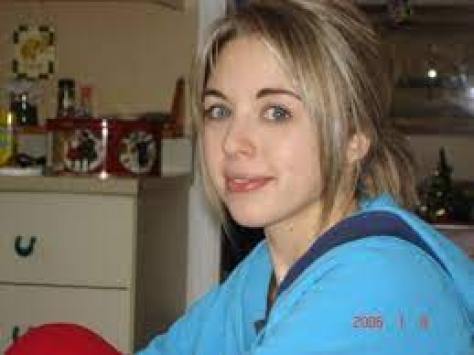
In the matter of the murder of Catherine Daviau, the Montreal police would rather the public not know precisely how she died. But I’ll tell you right now that Catherine Daviau was stabbed repeatedly in the neck and stomach, bound with zip ties on the bed of her Rosemont apartment, the room set on fire using her perfume as an accelerant, December 11th, 2008.
This is Who Killed Theresa
What the police saidThe following is the official notice from the Montreal Police / SPVM on the death of Catherine Daviau:
“Thursday, December 11, 2008, Catherine DAVIAU 26 years old, a young woman was found lifeless in her apartment in the Rosemont district during an intervention by the Montreal fire department at her home located at 5165 5th Avenue following a call to “911” from a neighbor who had noticed the fire.
Following the discovery of the body, the Montreal firefighters called on the SPVM. During the response, the police quickly found that the young woman had been the victim of a murder. Catherine DAVIAU was found on the bed of her room, she bore signs of violence. Investigators from the Major Crimes Section of the SPVM suspect that the attacker started the fire to hide his crime.
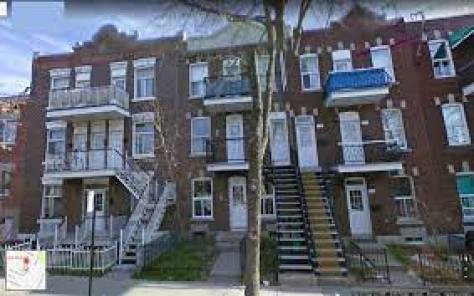 5165 5th Avenue
in the Rosemont district, Montreal
5165 5th Avenue
in the Rosemont district, MontrealDuring the investigation, the police learned that that day Catherine DAVIAU had worked all day at a company on the West Island of Montreal as she has been doing for several years. After her shift, around 4:30 p.m., she left her work to return home by car, taking Highway 40 eastbound. Given the heavy traffic that day, police estimate that she would have arrived home about an hour later. The investigation also reveals that the victim had used her cellular device shortly after 5:30 p.m. to communicate with an acquaintance.
A neighbor called “911” at around 7:07 pm. When the firefighters arrived, all the exits were closed and locked, which suggests that the victim let her attacker in and that there was no call of a break-in.
Given the victim’s likely arrival at her home and the t ime of the call to “911”, the perpetrator’s window of opportunity was a little over an hour .
As part of the SPVM investigation for several years, Catherine DAVIAU’s family, neighbors, friends and acquaintances were met by the police, but to date no solid investigative lead has been identified in order to elucidate the gratuitous murder of this uneventful young woman, brutally assaulted, inside her home in the Rosemont district.
Through this process, the SPVM is asking the public for assistance in order to identify the perpetrator of this violent crime. Anyone with information is asked to contact the SPVM, either by dialing 911, by going to a neighborhood police station, through our website or, anonymously, by contacting Info-Crime Montreal at 514-393-1123. Each information received will be processed and analyzed. The case will remain open until it is resolved.”
Some things you can deduce from this information: 5165 5e, that’s a nice area in the Rosemont district, wedged between Parc Extension and Hochelaga, east, in the shadow of the Surete du Quebec headquarters. It’s evident that the notice is made years after the 2008 murder, exactly when we don’t know. There’s a short video made by the SPVM that goes along with the notice, and that video was posted to YouTube in December 2017, so possibly nine years after the murder. This seems about right as the Montreal Police only created their cold case unit in December 2018. We’ve talked about how – to date – the SPVM has only posted 4 cold cases on that website, even though they have approximately 800 under their investigative mandate, Catherine Daviau is one of those four. For a suspect, they lean heavily on Catherine’s friends and family to develop clues, but come up empty. When that happens, the difficulty is the case becomes more and more reliant on police investigation. There’s a suspect out there, and only their expertise is going to find them.
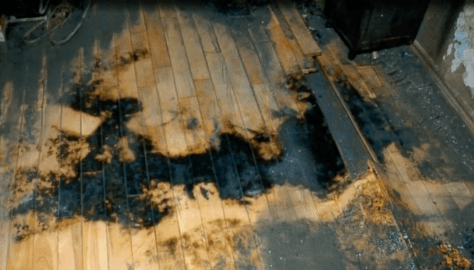 Daviau crime scene
Daviau crime sceneOne final thing, the case has never been covered by Montreal’s English language paper, The Gazette. As we’ve seen, this can happen. French papers tend to stick with French victims, where family members can be easily interviewed, and the same applies for English papers. Even CBC Montreal has done little beyond publishing the SPVM press releases, most of the in depth reporting has come from La Presse and Journal de Montreal. I questioned The Gazette about this, and was never given a satisfactory answer as to the lack of attention. It seems especially odd as Catherine Davieau appeared to be fluently bilingual (her mother’s maiden name is Schneider).
10th Anniversary UpdateIn March 2018 the Montreal Police provided updates on the case, presumably as a 10th anniversary push to try and advance the cold case. In the TVA program, JE they disclose that “tie wraps” or zip ties were used to restrain Catherine, even going to the extraordinary step of releasing crime scene photos of the exhibit evidence. The police inform the public that this is a definite indication that the murder was planned ( I suppose further re-enforcing that the assailant could have worked within the under-an-hour timeline if they had premeditated there actions).
The SPVM further disclose that they have physical evidence left at the scene of the crime, but do not say whether that is fingerprints or DNA. It becomes fairly obvious that it’s DNA, when in their next breath they disclose that the assailant smoked Player’s filtered cigarettes.
For the first time, Catherine’s younger sister, Geneviève, is interviewed about the murder:
“We already knew that Catherine would have returned from her work around 6 pm. She lived alone in an apartment on 5th Avenue. At 7:07 p.m., a neighbor called 911 to report a fire. It doesn’t leave a lot of time anyway. I still can’t believe that no one noticed someone or something fishy that evening,”
“Nouveaux éléments concernant le meurtre sordide de Catherine Daviau”, MARIE-CHRISTINE BERGERON, Journal de Montreal, March 15, 2018
After smashing down the apartment door, fire fighters found Catherine’s body naked on her bed. It is here that investigators also reveal that the man – it is the first time they disclose it was a man, presumably also derived from the DNA evidence – used Catherine’s perfume as an accelerator to start the fire, again releasing a photo of the crime scene evidence:
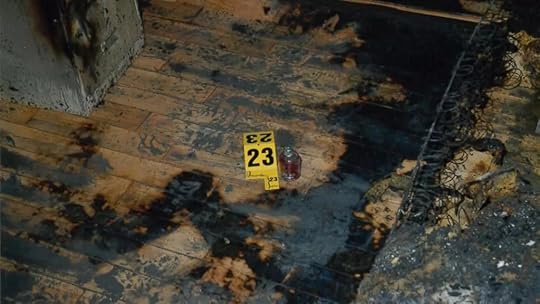 Evidence 23: Catherine Daviau’s perfume
Evidence 23: Catherine Daviau’s perfume“It tells us that the aggressor arrived on site with a plan, a plan already made. He knew what he wanted to do, that he wanted to tie up the victim to control her. So, it is clear that there is a premeditation. This guy may have followed or observed Catherine in her routine perhaps a few days or some time before to see her routine, ”
Investigator Antonio Paradiso of the SPVM.
The SPVM then go on to explain the nature of a cold case in patterned language that is all too familiar to readers of this website:
“The murder files remain active for two years. If after two years the investigation has not succeeded, in the jargon, we will say that it is a “cold case”. Then the file will be put on hold and my investigators will revise these files sporadically with the new information that comes in. These kinds of files, like Catherine’s, are never closed, ”
SPVM Commander Vincent Rozon
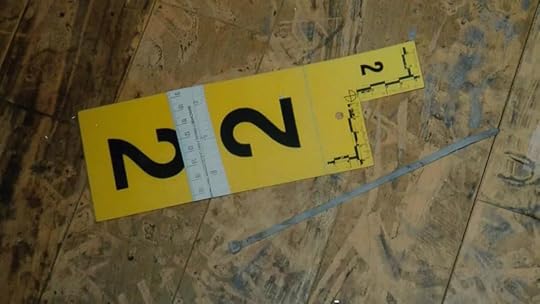 Evidence 2: Zip tie
Evidence 2: Zip tieAt the start of the investigation, the police refused to say whether Catherine had been sexually assaulted. By 2018, they had confirmed it, but refused to disclose the cause of her death:
“It’s important for investigators to keep certain items confidential, items secret. We call that “hold back”. If it is information that the suspect left at the scene and it is not mentioned outside the file, if one day some people talk about something that has never been said in the public, we will know that this is good information and we will treat it as a priority, ”
SPVM Investigator Paradiso.
Well I’m telling you right here and now that Catherine Daviau was stabbed repeatedly in the throat and stomach, as reported in her coroner report released over two years after her murder in 2010. It’s not very good hold-back evidence if that evidence is readily available to the public, and the coroner invites you to disclose it. Here I’ll translate what the Quebec coroner sent me:
“Mr. John Allore,
Enclosed you will find the coroner’s investigation report on the death by Catherine Daviau. Please note that coroners’ reports are public documents. They can therefore be given to anyone who requests it, including media representatives.
Please accept, Mr. John Allore, the expression of our distinguished feelings.”
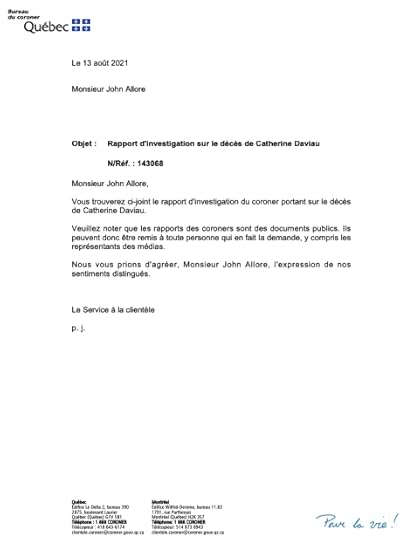 letter from coroner
letter from coronerI swear, the Journal de Montreal, they do a lot of good in these types of stories in disclosing information to the public, but it is all told through the lens of Quebec police. In this manner the JdM’s relationship with the SPVM is no better than Jack Webb’s Dragnet in the 50s and 60s, the popular crime television series was practically produced by the LAPD.
DNA PhenotypingIn December 2018, the Montreal Police announce that they have managed to develop a composite photo of Catherine Daviau’s assailant using advanced DNA techniques. The SPVM sent a DNA sample of the suspect found at the crime scene – presumably from the cigarette butt of the Player’s filter cigarette – to the United States to draw a composite image using a ground-breaking technique called phenotyping.
“It is a method of analyzing DNA samples that makes it possible to obtain probable physical characteristics of an unidentified person”, explained commander of the major crimes section of the SPVM, Pascal Côté.
The color of hair, eyes, skin and “certain morphological characteristics of the face” are among the elements that can emerge from such an analysis.
The composite was shown to Catherine Daviau’s entourage, but the SPVM refused to make the image public:
“The composite will not be made public… It could mislead the population and even the investigators in error… It should be understood that a robot portrait produced by the testimony of a person has much more value today with the technologies that are within our reach. A witness sees the length of the hair, the age of the person, certain characteristics that cannot be determined by a DNA sample. A composite portrait drawn from a DNA sample will be more generic,”
Pascal Côté – SPVM
The composite portrait drawn from the DNA cannot, among other things, reflect the age of the suspect, explained Pascal Côté. At that time in 2018 – ten years after Catherine’s murder, detectives were still investigating the hypothesis that Catherine Daviau may have been killed by someone she knew. It is particularly for this reason that they showed the composite portrait only to the entourage of young woman in Catherine’s social circle.
Again, this is troubling. The SPVM had been working the same hypothesis for a decade and gotten nowhere. Why did they think limiting the composite to a small circle of friends would get them any further? It’s the easiest investigative approach, but after ten years not really the one required. The SPVM told someone I know acquainted with the case that they are convinced Daviau was murdered by “de ses relations”, meaning someone she knew. I get why they think this, but operating only on this theory is absurd. Remember in the episode, Why Murders Are Unsolved, Montreal Police originally assumed the Wayne Boden murders were committed by someone the victims knew well, because the assailant gained easy access to the victims’ apartments. It wasn’t until after Boden was apprehended that police realized Boden wasn’t a close associate of any of the victims, he was a confidence man who barely knew them but managed to quickly manipulate his way into their lives, proving the Montreal Police has a real habit of repeating the same mistakes over and over again.
Of course the story and the interviews were handed directly to the Journal de Montreal. It’s informative, but again, unprofessional, and pure police propaganda. For 50 years the JdM has been a mouthpiece for whatever message Quebec police want to spin. In my sister’s case it was planting a story about a drug addict, then never visiting the case again. As we’ve discussed with the Teresa Martin case in 1969, again, the planting of a drug addict story to deflect attention away from the real story – that the Montreal police had screwed up in getting too close with biker gangs. These were attempts by the police to draw the public’s attention away from a problem, weaponizing the highest circulated newspaper in the province to do so. It’s a situation straight out of 60s American television:
“This is the city… It was Thursday, December 11th, we were working the night watch out of Bunko Division. My partner’s Antonio Paradiso, the boss is Commander Rozon. My name’s Friday….”
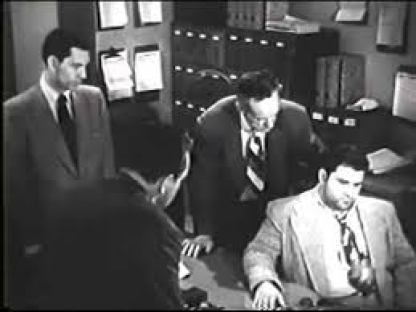 Dragnet – Season 1, episode 2 – Big Actor
Dragnet – Season 1, episode 2 – Big ActorDNA phenotyping is the process of predicting a person’s physical appearance and/or biogeographic ancestry for forensic purposes using only genetic information collected from genotyping or DNA sequencing. This term, also known as molecular photofitting.
It is believed to have been first used in 2015 to help solve the 2011 murders of Candra Alston and her three-year-old daughter. Police in Columbia, South Carolina, issued a press release containing what is thought to be the first composite image to be published entirely on the basis of a DNA sample. This lead to the arrest of Kenneth Canzater, who was charged with the murders in 2017.
 Phenotype composite for the Ljubica Topic case. The technology cannot predict the age of the assailant.
Phenotype composite for the Ljubica Topic case. The technology cannot predict the age of the assailant.In Canada the technique is believed to have been first used in 2016 when Windsor police released a composite of the suspect responsible for the abduction and murder of six-year-old Ljubica Topic in 1971. This was the first public release of a phenotyping composite outside of the United States and the oldest case to apply the technology.
Phenotyping is like the Zizzlingers of forensic science. Just add water, you never know who you’re gonna get.
 Disney Princess Zizzlingers
Disney Princess ZizzlingersAnd what of phenotyping related to solving other cold cases in Quebec? Are there plans to test other cold case evidence? There exists male DNA evidence in my sister’s case, will that sample be sent to the United States for phenotyping? I might like some confirmation that after phenotyping, the offender tends to resemble Luc Gregoire, who died in Archambault in 2015 after his sentencing for the Calgary murder of Lanie Silva. I have three victim rendered composites (2 from Sherbrooke, one from Montreal) that demonstrate a man resembling Gregoire was a serial sexual predator active in Quebec in the late 1970s. It would be nice to have genetic confirmation. It’s an expensive technique; so what is the rationale of testing only the Daviau evidence? What about the Teresa Martin case, shouldn’t the method be, oldest cases are the first ones tested? Or maybe it is the newest cases, while memories are still fresh. I know, I’m being a little overly ambitious by daring to suggest that perhaps there should be a strategic, coordinated effort here.
What about any number of cases, like Valerie Leblanc?
Valerie Leblanc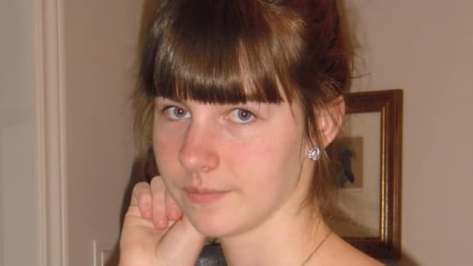 Valerie Leblanc, 18, was found dead in a forest behind her Gatineau, Que., school Cegep de l’Outaouais.
Valerie Leblanc, 18, was found dead in a forest behind her Gatineau, Que., school Cegep de l’Outaouais.In 2011 Valérie Leblanc was an 18-year-old student at the Cégep de l’Outaouais in Hull. The city of Hull rests across the Ottawa River from the Canadian Capital of Ottawa. In fact the river defines the border between the provinces of Ontario and Quebec.
On August 23, 2011, her badly beaten and burned corpse was discovered in the woods behind the campus of Cégep de l’Outaouais. Two students found the body around 4 p.m. near the bike path behind the school’s Campus Gabrielle-Roy. As reported by CBC News, Josianne Tardif was having a cigarette on the path with her friends – the place was a popular spot for local teenagers – when they came upon the body.
“She was lying down on her front, her legs were broken,” said Tardif, “at the time we didn’t believe it was real.” The two students originally thought the body was a mannequin, until they moved closer. “We kind of smelled the dead body burning, that’s when we realized what you saw. It was really excruciating,” she said. Leblanc’s body was transported to Montreal to process the autopsy. At the time, Gatineau police said the death was considered suspicious.
The location where the body was found was near a spot where in March 2010 a woman was found badly burned in what police later called an attempted suicide. The similarity of the incidents led some at the school and family members of Leblanc to speculate they were connected. But police said the 2010 incident was still considered an attempted suicide, while admitting that Leblanc’s “suspicious” death was not a suicide.
Body TamperingTwo days later, Gatineau police announced that Valerie Leblanc died from head trauma. They refused to comment further on the case, but said it did not appear the body had been moved from another location. Patrols consisting of the Gatineau police bicycle squad and the RCMP began to canvas the grounds and paths of the college campus. Police said they had no suspects in the homicide investigation.
Police then announced they had opened a second investigation into whether people who first came upon the body may have “manipulated” it. “Certain actions were taken by the people who discovered the body of Valérie Leblanc, so there is a second investigation to the one of murder,” said Gatineau police spokesman Sgt. Jean-Paul Le May. Le May went on to say that there were four suspects in the second investigation, which also included allegations of obstructing the homicide investigation. He said the people involved in the second investigation were not believed to be involved in the death of Leblanc. According to Le May, the four suspects may have potentially compromised the homicide investigation.
Eventually police revealed that the four suspects were teenagers who told police they were walking through the park when they saw smoke rising from an off-trail area. They went to investigate, and discovered Leblanc’s body with evidence of burns and other signs of violence. The teens later told police that they did not realize the body was real, so they returned to class. Eventually they decided something was wrong and phoned police.
The press reported that Leblanc and her boyfriend had recently broken up, and that they were seen entering the woods together that Tuesday morning. But police, while confirming the split between the couple, said that investigators met with the boyfriend and that he was not considered a suspect. Leblanc was a first year student at the cegep / college, according to police. She died on the first day of school of the fall semester.
Police release sketch of ‘important witness’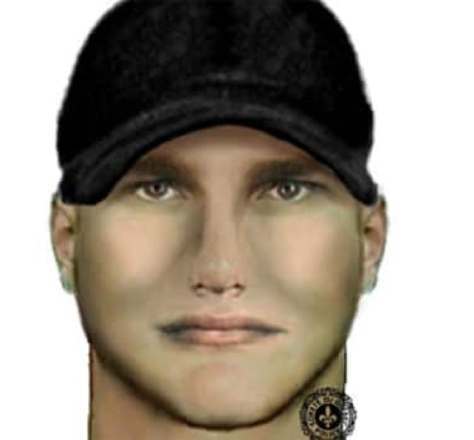 Police issued this sketch of a witness to be identified several months after Valérie Leblanc’s body was found in August 2011. (Gatineau Police)
Police issued this sketch of a witness to be identified several months after Valérie Leblanc’s body was found in August 2011. (Gatineau Police)Two months later the trail from Valerie Leblanc’s murder goes cold. Valerie’s mother holds a press conference pleading for the public’s help. “We want the police officers to find who is responsible for this horrible murder and make sure the person is arrested and convicted,” she says.
Gatineau Police say they still have no suspects, but they do release a sketch of a man described as an “important witness” in the slaying who was seen wearing a black hat. They say there have been more than 500 tips related to this homicide investigation and repeat their call for more information. The force also offers a $10,000 reward for information related to the case. The “important witness” is described as a white man in his 20s, about six feet tall and 200 pounds, with a chubby face, short black hair, no facial hair and a pot belly. He is French-speaking. He also had a summer tan “with a particular olive complexion.” He has a pointy nose and walks with a limp. He may have been riding a bicycle. The bicycle is described as a mountain bike with straight handlebars. Police say the bike appears to be a lower end model and that it had mountain or hybrid tires.
The witness was also said to be wearing an open black nylon jacket, along with a black T-shirt with a red and golden logo, a black cap and black wrinkled pants. He was walking decisively and looked worried. Later other witnesses claim the man was not wearing a black cap, but of course by this time police had already released their composite showing the man in a black hat. The Gatineau police declared they had no suspects but their chief defended the investigation, saying they did not believe the case should be turned over to the more experienced provincial police, the Surete du Quebec.
By December 2011, with still no progress on the murder investigation, the office of the Crown attorney announces that no charges will be laid in the matter of tampering with Valérie Leblanc’s body. Police reveal that originally four teenagers were suspected to have tampered with the murder scene. However, three were cleared by police in September, with the fourth person cleared in December. Officials say there is no discrepancy as to whether or not the body was tampered with, but they will not move forward with charges based on the evidence. It’s never quite clear what exactly the nature of the body tampering was, but many assume it was either the setting of the corps on fire, or the breaking of the legs. “Of course they touched (the body), but we cannot say how,” a police spokesman explained at the time.
Leblanc memorial vandalized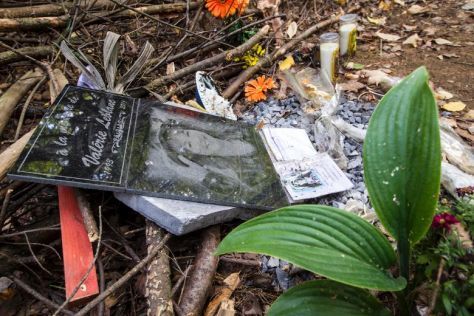
On the one year anniversary of her death, a memorial to Valerie Leblanc erected along the bike path where she was found is vandalized. Valerie’s grandmother says she believes the person(s) who desecrated the memorial could be linked to the killing.
“They say a murderer or some murderers always come back to the site of their act,” said Huguette Leblanc, “It could be that, too, it’s starting to affect them inside and in their head.”
At exactly 4 p.m. – one year to the hour that his granddaughter’s body was discovered – Bert Leblanc went to visit the memorial site and discovered it had been trashed — a cross was broken, a commemorative plaque cracked, a picture of Valerie had the face scratched out and a crucifix with a wolf’s head on it had been unearthed. He also found cases of beer and broken bottles scattered around the memorial site. Bert Leblanc shared his experience with the Gatineau Police but they said it was too early in the investigation to draw any possible links between the vandalism and the murder.
Now… given that you had no leads and no suspects, wouldn’t you take the vandalism a little more seriously? For the sake of the family, wouldn’t you – at the very least – give the appearance that you were taking it seriously and not dismissing the incident outright? Given how much the family had suffered, given that you already had the evidence of body tampering, conducted by teenagers, given that your lack of experience had already been called into question… wouldn’t you, as the investigating force, start to focus the investigation closer to home, and stop pinning your hopes on an phantom “important witness” who may not even exist. A figment who may have been created by those teenagers to throw the focus of the investigation in a direction other than the Cégep de l’Outaouais.
Claude Poirier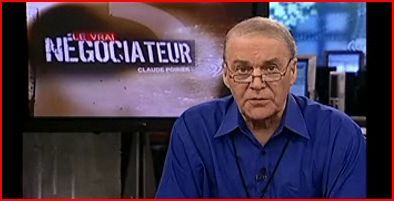 Claude Poirier
Claude PoirierIt didn’t take long for the Valerie Leblanc investigation to devolve into the circus it was destined to become. This is what happens when you have a police force that is completely out of their depth with criminal matters, they become prey to outside elements that – with the best intentions – manage to complicate and confuse things even further.
Enter Claude Poirier.
In the fall of 2013, the second anniversary of Valérie Leblanc’s murder, Claude Poirier hosts a television call-in show on Quebec’s TVA television station. On the TVA program an anonymous caller claimed Leblanc’s killer committed suicide a month after the 18-year-old’s mutilated and burned body was found behind the CEGEP de l’Outaouais in August, 2011. The caller to Claude Poirier’s show, who claimed to be resident of Gatineau, said he received his information from an unnamed, recently retired police officer.
“We must come to an end with this atrocity there,” he told TVA host Poirier. “I hold information that will confirm that we will never find the perpetrator of Valerie Leblanc, because the individual has committed suicide not long after in the Gatineau Park.”
Police quickly qualify this information as “unfounded”. Claude Poirier confirms that he receives lots of information on the Leblanc investigation: “I received information on my voicemail, on my site, on my pager. I passed everything on to two lieutenants. Still, I received extremely plausible things, ”he says.
Valerie’s grandmother, Huguette Leblanc, says the one thing that seems to make common sense, that the assertion is difficult to believe. “I’m glad people are still talking about it, but I don’t believe it,” she said. “I doubt a police officer would talk like that. If it was true, there would be proof, we’d already know about it. My feeling is people like to say things to get attention.”
“It’s bringing me down so much”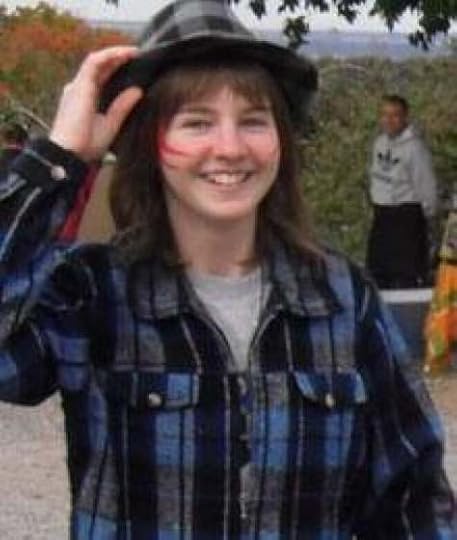 Valérie Leblanc, 18, was just beginning her second year at CEGEP de l’Outaouais in Gatineau when she was found dead in a forest behind her school.
Valérie Leblanc, 18, was just beginning her second year at CEGEP de l’Outaouais in Gatineau when she was found dead in a forest behind her school.Nine years later and police still hadn’t gotten very far with the Valérie Leblanc murder investigation. Valerie’s mother does annual press conferences to try and keep the case alive.
“I just miss her … and every year that goes on, it’s like we’re going [through] that again. It’s bringing me down so much,” Leblanc’s mother Julie Charron tells CBC News.
Gatineau police continue to state that they would like to speak with the male witness from their issued sketch. “We’re still at the point where we would like to meet with the important witness in our case,” says Jean-Paul Lemay of the Gatineau Police Service.
Anyone with information is asked to call the Gatineau Police Service’s homicide line at 819 243-INFO (4636).
By 2020 Claude Poirier had conducted his own investigation in the hope of shedding light on the homicide, on his program, Poirier Enquete. The Poirier problem is that he’s just like Dragnet. Another Quebecor / TVA product, there’s no objective distance, he is right in the police’s pocket. And there’s the added danger of when Poirier goes rogue; like he did with the anonymous caller on the 2013 television program, as he did with the 1997 disappearance of Cédrika Provencher.
———————————
I suspect that police already know this, but have elected to put up a front. The best suspect is not some “important witness” who may or may not exist. The best suspect in the Valerie Leblanc case – and I feel this is something very different from the Catherine Daviau case – is, in fact, someone closely associated with her at the cegep campus in Hull.
Leblanc’s coroner’s report is not very telling, but it does reveal this:
“[Mme Leblanc] had gone to the wooded area behind the CEGEP, which is very popular with students, with a friend around 1 pm. The friend in question left the woods some thirty minutes later. Other students found Mme Leblanc there dead and made a call to 911 at around 3:55 p.m.”
We know from press reports that the “friend” is Valérie’s boyfriend with whom she had recently broken up. Two go in, one comes out. And there is an approximate two-and-a-half hour window in which the body tampering could have occurred. I would guess that the boyfriend is the police’s prime suspect. There simply are no witnesses – or none ready to tell what they know – and the boyfriend hasn’t ever broken, he won’t confess.
If you’re looking for a more in-depth study of the Valerie Leblanc case, check out the podcast Synthèses, produced by QUB Radio ( yet another Quebecor offering). Synthèses is the brainchild of Boris Proulx and Julien Morissette, and they’ve now produced two series on unsolved murders, the one on Leblanc and a second series on the death of Louise Chaput, a 52-year-old Quebec woman whose body was found in 2001 at Pinkham Notch in the White Mountains of New Hampshire. Their podcasts for a time were hard to find, but they’ve recently been posted on Apple Podcasts.( I’ve posted the link here). Morissette and Proulx’s work is excellent, definitely worth checking out. The only problem is they are in French, so you need to brush up on your Parlez-Vous.
Louis Chaput was from Sherbrooke, which is as good a transition as you’re gonna get for our next segment….
“We will shine a light on these events” Sherbrooke Police Chief Danny McConnell explained that a witness at the scene said somebody had lit a mannequin on fire.
Sherbrooke Police Chief Danny McConnell explained that a witness at the scene said somebody had lit a mannequin on fire.Now those that know me have already guessed where this is all leading to, why I chose to tell these stories at this particular point in time. For years, I have been asked to cover the cases of Daviau and Leblanc. I just have never been able to find quite the right hook, the right angle. It’s one thing for some teenagers to mistake a burnt body for a mannequin, they’re kids, not professional investigators. We even begin the book Wish You Were Here with the discovery of the body and how the muskrat trapper thought the victim was a mannequin. That’s a true story, but we also wanted to play off the old trope – because it always seems that crime stories begin this way, with an old cliche, but then we wanted to take the book in a very different direction.
So imagine my surprise a few weeks ago when police and fire fighters from the city of Sherbrooke, Quebec literally mistook a burning body for a mannequin, and then collectively made the decision to dispose of said mannequin in a nearby dumpster.
———————–
On the morning of July 23, 2021, police and firefighters responded to a call made by employees on break from the AMF Factory in southern Sherbrooke. The workers say they saw someone set fire to a mannequin in a wooded area at the corner of Rue Cabana and Roy. According to Sherbrooke police chief Danny McConnell, the body was initially believed to be a silicone dummy. After discussions between police and firefighters, it was decided the best way to dispose of the mannequin was to put it into a dumpster behind the police station.
Four hours later, a man reported the disappearance of his partner. Police tracked her cell phone and found her vehicle near the scene of the fire. The woman’s description matched that of the supposed mannequin. Police, noting the coincidence, decided at 6:30 p.m. to check the dumpster and discovered the mannequin was… ya, the rest writes itself.
According to CTV News, the coroner’s office, Crown and independent bureau of investigators (BEI) are all looking into the situation. Police are investigating it as a suspicious death. In a news conference McConnell offered his condolences to the woman’s family. “We are obviously sorry for this incident and we assure you the family will be advised throughout this investigation,” he said. Sherbrooke fire chief Stephane Simoneau said many firefighters were shocked by the discovery and he is concerned about the psychological toll the situation may cause, adding that he is personally taking on the responsibility to determine what exactly occurred.
“We will shine a light on these events over the next few weeks,” he said.
On the subject of shining light, what I find interesting is the dark blanket that appears to have been thrown over this matter. From what I can tell, most of the reporting from the initial week of the incident -from July 22 when the body was discovered to the following week – has been wiped from the internet, the majority of coverage only picks up a week later on July 29, from the point of the police apology. What has also been dropped is that the AMF workers say they saw someone light a body on fire. In later news coverage the reporting only says a police responded to a body on fire, but you can hear it as clear as day on this CBC report:
The story that has emerged is that a woman in her 60s appears to have taken her own life, but there’s no telling that that is actually what occurred. We’ve seen this before, burning the victim or crime scene to obfuscate the murder, most notably the case of Diane Thibeault, but also in the Catherine Daviau case, and possibly also with Valerie Leblanc. Full disclosure; the only thing connecting the Daviau and Leblanc cases is the burning of the victims, apart from that I see little in common with their dossiers.
Far from shining light, the police have maintained stone silence since the public apology on July 29. As Viatka Sundborg reported in the French language, le Soleil, “”Silence” is the watchword in the file”. Here I’ll read from Sundborg’s August 3rd article, what appears to be the last word on the matter for the time being:
“An investigation by the coroner’s office is underway, says Jake Lamotta Granato, responsible for communications and media relations. “M. Richard Drapeau is responsible for this file and no comments will be made before the publication of the report,” he adds.
Ten days after the tragedy, the same questions as last week therefore remain unanswered. The identity of the victim remains unknown, in addition to the circumstances of their death. All say they are waiting for the coroner’s report before commenting further on the tragedy….
According to the Bureau du coroner du Québec, “in 2018-2019, the average time to produce this type of report was 11 months. “”
Le Soleil
On the matter of the timing of the release of coroner information it is worth noting it took over a year for the coroner to produce the report for Valerie Leblanc. In the matter of Catherine Daviau’s death, over two years. With the murder of Siasi Tullaugak which we covered a couple of episodes ago, the coroner waited 21 months.
I’m eagerly awaiting the part in this story when we’re officially told to go away, ‘This is a local matter, please let our community heal’.
It’s very dangerous to forget.
The post Spontaneous Combustion / Catherine Daviau & Valérie Leblanc – WKT5 #13 first appeared on WHO KILLED THERESA?.Spontaneous Combustion / Catherine Daviau & Valerie Leblanc – WKT5 #13

In the matter of the murder of Catherine Daviau, the Montreal police would rather the public not know precisely how she died. But I’ll tell you right now that Catherine Daviau was stabbed repeatedly in the neck and stomach, bound with zip ties on the bed of her Rosemont apartment, the room set on fire using her perfume as an accelerant, December 11th, 2008.
This is Who Killed Theresa
What the police saidThe following is the official notice from the Montreal Police / SPVM on the death of Catherine Daviau:
“Thursday, December 11, 2008, Catherine DAVIAU 26 years old, a young woman was found lifeless in her apartment in the Rosemont district during an intervention by the Montreal fire department at her home located at 5165 5th Avenue following a call to “911” from a neighbor who had noticed the fire.
Following the discovery of the body, the Montreal firefighters called on the SPVM. During the response, the police quickly found that the young woman had been the victim of a murder. Catherine DAVIAU was found on the bed of her room, she bore signs of violence. Investigators from the Major Crimes Section of the SPVM suspect that the attacker started the fire to hide his crime.
 5165 5th Avenue
in the Rosemont district, Montreal
5165 5th Avenue
in the Rosemont district, MontrealDuring the investigation, the police learned that that day Catherine DAVIAU had worked all day at a company on the West Island of Montreal as she has been doing for several years. After her shift, around 4:30 p.m., she left her work to return home by car, taking Highway 40 eastbound. Given the heavy traffic that day, police estimate that she would have arrived home about an hour later. The investigation also reveals that the victim had used her cellular device shortly after 5:30 p.m. to communicate with an acquaintance.
A neighbor called “911” at around 7:07 pm. When the firefighters arrived, all the exits were closed and locked, which suggests that the victim let her attacker in and that there was no call of a break-in.
Given the victim’s likely arrival at her home and the t ime of the call to “911”, the perpetrator’s window of opportunity was a little over an hour .
As part of the SPVM investigation for several years, Catherine DAVIAU’s family, neighbors, friends and acquaintances were met by the police, but to date no solid investigative lead has been identified in order to elucidate the gratuitous murder of this uneventful young woman, brutally assaulted, inside her home in the Rosemont district.
Through this process, the SPVM is asking the public for assistance in order to identify the perpetrator of this violent crime. Anyone with information is asked to contact the SPVM, either by dialing 911, by going to a neighborhood police station, through our website or, anonymously, by contacting Info-Crime Montreal at 514-393-1123. Each information received will be processed and analyzed. The case will remain open until it is resolved.”
Some things you can deduce from this information: 5165 5e, that’s a nice area in the Rosemont district, wedged between Parc Extension and Hochelaga, east, in the shadow of the Surete du Quebec headquarters. It’s evident that the notice is made years after the 2008 murder, exactly when we don’t know. There’s a short video made by the SPVM that goes along with the notice, and that video was posted to YouTube in December 2017, so possibly nine years after the murder. This seems about right as the Montreal Police only created their cold case unit in December 2018. We’ve talked about how – to date – the SPVM has only posted 4 cold cases on that website, even though they have approximately 800 under their investigative mandate, Catherine Daviau is one of those four. For a suspect, they lean heavily on Catherine’s friends and family to develop clues, but come up empty. When that happens, the difficulty is the case becomes more and more reliant on police investigation. There’s a suspect out there, and only their expertise is going to find them.
 Daviau crime scene
Daviau crime sceneOne final thing, the case has never been covered by Montreal’s English language paper, The Gazette. As we’ve seen, this can happen. French papers tend to stick with French victims, where family members can be easily interviewed, and the same applies for English papers. Even CBC Montreal has done little beyond publishing the SPVM press releases, most of the in depth reporting has come from La Presse and Journal de Montreal. I questioned The Gazette about this, and was never given a satisfactory answer as to the lack of attention. It seems especially odd as Catherine Davieau appeared to be fluently bilingual (her mother’s maiden name is Schneider).
10th Anniversary UpdateIn March 2018 the Montreal Police provided updates on the case, presumably as a 10th anniversary push to try and advance the cold case. In the TVA program, JE they disclose that “tie wraps” or zip ties were used to restrain Catherine, even going to the extraordinary step of releasing crime scene photos of the exhibit evidence. The police inform the public that this is a definite indication that the murder was planned ( I suppose further re-enforcing that the assailant could have worked within the under-an-hour timeline if they had premeditated there actions).
The SPVM further disclose that they have physical evidence left at the scene of the crime, but do not say whether that is fingerprints or DNA. It becomes fairly obvious that it’s DNA, when in their next breath they disclose that the assailant smoked Player’s filtered cigarettes.
For the first time, Catherine’s younger sister, Geneviève, is interviewed about the murder:
“We already knew that Catherine would have returned from her work around 6 pm. She lived alone in an apartment on 5th Avenue. At 7:07 p.m., a neighbor called 911 to report a fire. It doesn’t leave a lot of time anyway. I still can’t believe that no one noticed someone or something fishy that evening,”
“Nouveaux éléments concernant le meurtre sordide de Catherine Daviau”, MARIE-CHRISTINE BERGERON, Journal de Montreal, March 15, 2018
After smashing down the apartment door, fire fighters found Catherine’s body naked on her bed. It is here that investigators also reveal that the man – it is the first time they disclose it was a man, presumably also derived from the DNA evidence – used Catherine’s perfume as an accelerator to start the fire, again releasing a photo of the crime scene evidence:
 Evidence 23: Catherine Daviau’s perfume
Evidence 23: Catherine Daviau’s perfume“It tells us that the aggressor arrived on site with a plan, a plan already made. He knew what he wanted to do, that he wanted to tie up the victim to control her. So, it is clear that there is a premeditation. This guy may have followed or observed Catherine in her routine perhaps a few days or some time before to see her routine, ”
Investigator Antonio Paradiso of the SPVM.
The SPVM then go on to explain the nature of a cold case in patterned language that is all too familiar to readers of this website:
“The murder files remain active for two years. If after two years the investigation has not succeeded, in the jargon, we will say that it is a “cold case”. Then the file will be put on hold and my investigators will revise these files sporadically with the new information that comes in. These kinds of files, like Catherine’s, are never closed, ”
SPVM Commander Vincent Rozon
 Evidence 2: Zip tie
Evidence 2: Zip tieAt the start of the investigation, the police refused to say whether Catherine had been sexually assaulted. By 2018, they had confirmed it, but refused to disclose the cause of her death:
“It’s important for investigators to keep certain items confidential, items secret. We call that “hold back”. If it is information that the suspect left at the scene and it is not mentioned outside the file, if one day some people talk about something that has never been said in the public, we will know that this is good information and we will treat it as a priority, ”
SPVM Investigator Paradiso.
Well I’m telling you right here and now that Catherine Daviau was stabbed repeatedly in the throat and stomach, as reported in her coroner report released over two years after her murder in 2010. It’s not very good hold-back evidence if that evidence is readily available to the public, and the coroner invites you to disclose it. Here I’ll translate what the Quebec coroner sent me:
“Mr. John Allore,
Enclosed you will find the coroner’s investigation report on the death by Catherine Daviau. Please note that coroners’ reports are public documents. They can therefore be given to anyone who requests it, including media representatives.
Please accept, Mr. John Allore, the expression of our distinguished feelings.”
 letter from coroner
letter from coronerI swear, the Journal de Montreal, they do a lot of good in these types of stories in disclosing information to the public, but it is all told through the lens of Quebec police. In this manner the JdM’s relationship with the SPVM is no better than Jack Webb’s Dragnet in the 50s and 60s, the popular crime television series was practically produced by the LAPD.
DNA PhenotypingIn December 2018, the Montreal Police announce that they have managed to develop a composite photo of Catherine Daviau’s assailant using advanced DNA techniques. The SPVM sent a DNA sample of the suspect found at the crime scene – presumably from the cigarette butt of the Player’s filter cigarette – to the United States to draw a composite image using a ground-breaking technique called phenotyping.
“It is a method of analyzing DNA samples that makes it possible to obtain probable physical characteristics of an unidentified person”, explained commander of the major crimes section of the SPVM, Pascal Côté.
The color of hair, eyes, skin and “certain morphological characteristics of the face” are among the elements that can emerge from such an analysis.
The composite was shown to Catherine Daviau’s entourage, but the SPVM refused to make the image public:
“The composite will not be made public… It could mislead the population and even the investigators in error… It should be understood that a robot portrait produced by the testimony of a person has much more value today with the technologies that are within our reach. A witness sees the length of the hair, the age of the person, certain characteristics that cannot be determined by a DNA sample. A composite portrait drawn from a DNA sample will be more generic,”
Pascal Côté – SPVM
The composite portrait drawn from the DNA cannot, among other things, reflect the age of the suspect, explained Pascal Côté. At that time in 2018 – ten years after Catherine’s murder, detectives were still investigating the hypothesis that Catherine Daviau may have been killed by someone she knew. It is particularly for this reason that they showed the composite portrait only to the entourage of young woman in Catherine’s social circle.
Again, this is troubling. The SPVM had been working the same hypothesis for a decade and gotten nowhere. Why did they think limiting the composite to a small circle of friends would get them any further? It’s the easiest investigative approach, but after ten years not really the one required. The SPVM told someone I know acquainted with the case that they are convinced Daviau was murdered by “de ses relations”, meaning someone she knew. I get why they think this, but operating only on this theory is absurd. Remember in the episode, Why Murders Are Unsolved, Montreal Police originally assumed the Wayne Boden murders were committed by someone the victims knew well, because the assailant gained easy access to the victims’ apartments. It wasn’t until after Boden was apprehended that police realized Boden wasn’t a close associate of any of the victims, he was a confidence man who barely knew them but managed to quickly manipulate his way into their lives, proving the Montreal Police has a real habit of repeating the same mistakes over and over again.
Of course the story and the interviews were handed directly to the Journal de Montreal. It’s informative, but again, unprofessional, and pure police propaganda. For 50 years the JdM has been a mouthpiece for whatever message Quebec police want to spin. In my sister’s case it was planting a story about a drug addict, then never visiting the case again. As we’ve discussed with the Teresa Martin case in 1969, again, the planting of a drug addict story to deflect attention away from the real story – that the Montreal police had screwed up in getting too close with biker gangs. These were attempts by the police to draw the public’s attention away from a problem, weaponizing the highest circulated newspaper in the province to do so. It’s a situation straight out of 60s American television:
“This is the city… It was Thursday, December 11th, we were working the night watch out of Bunko Division. My partner’s Antonio Paradiso, the boss is Commander Rozon. My name’s Friday….”
 Dragnet – Season 1, episode 2 – Big Actor
Dragnet – Season 1, episode 2 – Big ActorDNA phenotyping is the process of predicting a person’s physical appearance and/or biogeographic ancestry for forensic purposes using only genetic information collected from genotyping or DNA sequencing. This term, also known as molecular photofitting.
It is believed to have been first used in 2015 to help solve the 2011 murders of Candra Alston and her three-year-old daughter. Police in Columbia, South Carolina, issued a press release containing what is thought to be the first composite image to be published entirely on the basis of a DNA sample. This lead to the arrest of Kenneth Canzater, who was charged with the murders in 2017.
In Canada the technique is believed to have been first used in 2016 when Windsor police released a composite of the suspect responsible for the abduction and murder of six-year-old Ljubica Topic in 1971. This was the first public release of a phenotyping composite outside of the United States and the oldest case to apply the technology.
 Phenotype composite for the Ljubica Topic case. The technology cannot predict the age of the assailant.
Phenotype composite for the Ljubica Topic case. The technology cannot predict the age of the assailant.And what of phenotyping related to solving other cold cases in Quebec? Are there plans to test other cold case evidence? There exists male DNA evidence in my sister’s case, will that sample be sent to the United States for phenotyping? I might like some confirmation that after phenotyping, the offender tends to resemble Luc Gregoire, who died in Archambault in 2015 after his sentencing for the Calgary murder of Lanie Silva. I have three victim rendered composites (2 from Sherbrooke, one from Montreal) that demonstrate a man resembling Gregoire was a serial sexual predator active in Quebec in the late 1970s. It would be nice to have genetic confirmation. It’s an expensive technique; so what is the rationale of testing only the Daviau evidence? What about the Teresa Martin case, shouldn’t the method be, oldest cases are the first ones tested? Or maybe it is the newest cases, while memories are still fresh. I know, I’m being a little overly ambitious by daring to suggest that perhaps there should be a strategic, coordinated effort here.
What about any number of cases, like Valerie Leblanc?
Valerie Leblanc Valerie Leblanc, 18, was found dead in a forest behind her Gatineau, Que., school Cegep de l’Outaouais.
Valerie Leblanc, 18, was found dead in a forest behind her Gatineau, Que., school Cegep de l’Outaouais.In 2011 Valerie Leblanc was an 18-year-old student at the Cégep de l’Outaouais in Hull. The city of Hull rests across the Ottawa River from the Canadian Capital of Ottawa. In fact the river defines the border between the provinces of Ontario and Quebec.
On August 23, 2011, her badly beaten and burned body was discovered in the woods behind the campus of Cégep de l’Outaouais. Two students found the body around 4 p.m. near the bike path behind the school’s Campus Gabrielle-Roy. As reported by CBC News, Josianne Tardif was having a cigarette on the path with her friends – the place was a popular spot for local teenagers – when they came upon the body.
“She was lying down on her front, her legs were broken,” said Tardif, “at the time we didn’t believe it was real.” The two students originally thought the body was a mannequin, until they moved closer. “We kind of smelled the dead body burning, that’s when we realized what you saw. It was really excruciating,” she said. Leblanc’s body was transported to Montreal to process the autopsy. At the time, Gatineau police said the death was considered suspicious.
The location where the body was found was near a spot where in March 2010 a woman was found badly burned in what police later called an attempted suicide. The similarity of the incidents led some at the school and family members of Leblanc to speculate they were connected. But police said the 2010 incident was still considered an attempted suicide, while admitting that Leblanc’s “suspicious” death was not a suicide.
Body TamperingTwo days later, Gatineau police announced that Valerie Leblanc died from head trauma. They refused to comment further on the case, but said it did not appear the body had been moved from another location. Patrols consisting of the Gatineau police bicycle squad and the RCMP began to canvas the grounds and paths of the college campus. Police said they had no suspects in the homicide investigation.
Police then announced they had opened a second investigation into whether people who first came upon the body may have “manipulated” it. “Certain actions were taken by the people who discovered the body of Valerie Leblanc, so there is a second investigation to the one of murder,” said Gatineau police spokesman Sgt. Jean-Paul Le May. Le May went on to say that there were four suspects in the second investigation, which also included allegations of obstructing the homicide investigation. He said the people involved in the second investigation were not believed to be involved in the death of Leblanc. According to Le May, the four suspects may have potentially compromised the homicide investigation.
Eventually police revealed that the four suspects were teenagers who told police they were walking through the park when they saw smoke rising from an off-trail area. They went to investigate, and discovered Leblanc’s body with evidence of burns and other signs of violence. The teens later told police that they did not realize the body was real, so they returned to class. Eventually they decided something was wrong and phoned police.
The press reported that Leblanc and her boyfriend had recently broken up, and that they were seen entering the woods together that Tuesday morning. But police, while confirming the split between the couple, said that investigators met with the boyfriend and that he was not considered a suspect. Leblanc was a first year student at the cegep / college, according to police. She died on the first day of school of the fall semester.
Police release sketch of ‘important witness’ Police issued this sketch of a witness to be identified several months after Valérie Leblanc’s body was found in August 2011. (Gatineau Police)
Police issued this sketch of a witness to be identified several months after Valérie Leblanc’s body was found in August 2011. (Gatineau Police)Two months later the trail from Valerie Leblanc’s murder goes cold. Valerie’s mother holds a press conference pleading for the public’s help. “We want the police officers to find who is responsible for this horrible murder and make sure the person is arrested and convicted,” she says.
Gatineau Police say they still have no suspects, but they do release a sketch of a man described as an “important witness” in the slaying who was seen wearing a black hat. They say there have been more than 500 tips related to this homicide investigation and repeat their call for more information. The force also offers a $10,000 reward for information related to the case. The “important witness” is described as a white man in his 20s, about six feet tall and 200 pounds, with a chubby face, short black hair, no facial hair and a pot belly. He is French-speaking. He also had a summer tan “with a particular olive complexion.” He has a pointy nose and walks with a limp. He may have been riding a bicycle. The bicycle is described as a mountain bike with straight handlebars. Police say the bike appears to be a lower end model and that it had mountain or hybrid tires.
The witness was also said to be wearing an open black nylon jacket, along with a black T-shirt with a red and golden logo, a black cap and black wrinkled pants. He was walking decisively and looked worried. Later other witnesses claim the man was not wearing a black cap, but of course by this time police had already released their composite showing the man in a black hat. The Gatineau police declared they had no suspects but their chief defended the investigation, saying they did not believe the case should be turned over to the more experienced provincial police, the Surete du Quebec.
By December 2011, with still no progress on the murder investigation, the office of the Crown attorney announces that no charges will be laid in the matter of tampering with Valerie Leblanc’s body. Police reveal that originally four teenagers were suspected to have tampered with the murder scene. However, three were cleared by police in September, with the fourth person cleared in December. Officials say there is no discrepancy as to whether or not the body was tampered with, but they will not move forward with charges based on the evidence. It’s never quite clear what exactly the nature of the body tampering was, but many assume it was the setting of the corps on fire. “Of course they touched (the body), but we cannot say how,” a police spokesman explained at the time.
Leblanc memorial vandalized
On the one year anniversary of her death, a memorial to Valerie Leblanc erected along the bike path where she was found is vandalized. Valerie’s grandmother says she believes the person(s) who desecrated the memorial could be linked to the killing.
“They say a murderer or some murderers always come back to the site of their act,” said Huguette Leblanc, “It could be that, too, it’s starting to affect them inside and in their head.”
At exactly 4 p.m. – one year to the hour that his granddaughter’s body was discovered – Bert Leblanc went to visit the memorial site and discovered it had been trashed — a cross was broken, a commemorative plaque cracked, a picture of Valerie had the face scratched out and a crucifix with a wolf’s head on it had been unearthed. He also found cases of beer and broken bottles scattered around the memorial site. Bert Leblanc shared his experience with the Gatineau Police but they said it was too early in the investigation to draw any possible links between the vandalism and the murder.
Now… given that you had no leads and no suspects, wouldn’t you take the vandalism a little more seriously? For the sake of the family, wouldn’t you – at the very least – give the appearance that you were taking it seriously and not dismissing the incident outright? Given how much the family had suffered, given that you already had the evidence of body tampering, conducted by teenagers, given that your lack of experience had already been called into question… wouldn’t you, as the investigating force, start to focus the investigation closer to home, and stop pinning your hopes on an phantom “important witness” who may not even exist. A figment who may have been created by those teenagers to throw the focus of the investigation in a direction other than the Cégep de l’Outaouais.
Claude Poirier Claude Poirier
Claude PoirierIt didn’t take long for the Valerie Leblanc investigation to devolve into the circus it was destined to become. This is what happens when you have a police force that is completely out of their depth with criminal matters, they become prey to outside elements that – with the best intentions – manage to complicate and confuse things even further.
Enter Claude Poirier.
In the fall of 2013, the second anniversary of Valerie Leblanc’s murder, Claude Poirier hosts a television call-in show on Quebec’s TVA television station. On the TVA program an anonymous caller claimed Leblanc’s killer committed suicide a month after the 18-year-old’s mutilated and burned body was found behind the CEGEP de l’Outaouais in August, 2011. The caller to Claude Poirier’s show, who claimed to be resident of Gatineau, said he received his information from an unnamed, recently retired police officer.
“We must come to an end with this atrocity there,” he told TVA host Poirier. “I hold information that will confirm that we will never find the perpetrator of Valerie Leblanc, because the individual has committed suicide not long after in the Gatineau Park.”
Police quickly qualify this information as “unfounded”. Claude Poirier confirms that he receives lots of information on the Leblanc investigation: “I received information on my voicemail, on my site, on my pager. I passed everything on to two lieutenants. Still, I received extremely plausible things, ”he says.
Valerie’s grandmother, Huguette Leblanc, says the one thing that seems to make common sense, that the assertion is difficult to believe. “I’m glad people are still talking about it, but I don’t believe it,” she said. “I doubt a police officer would talk like that. If it was true, there would be proof, we’d already know about it. My feeling is people like to say things to get attention.”
“It’s bringing me down so much” Valérie Leblanc, 18, was just beginning her second year at CEGEP de l’Outaouais in Gatineau when she was found dead in a forest behind her school.
Valérie Leblanc, 18, was just beginning her second year at CEGEP de l’Outaouais in Gatineau when she was found dead in a forest behind her school.Nine years later and police still hadn’t gotten very far with the Valerie Leblanc murder investigation. Valerie’s mother does annual press conferences to try and keep the case alive.
“I just miss her … and every year that goes on, it’s like we’re going [through] that again. It’s bringing me down so much,” Leblanc’s mother Julie Charron tells CBC News.
Gatineau police continue to state that they would like to speak with the male witness from their issued sketch. “We’re still at the point where we would like to meet with the important witness in our case,” says Jean-Paul Lemay of the Gatineau Police Service.
Anyone with information is asked to call the Gatineau Police Service’s homicide line at 819 243-INFO (4636).
By 2020 Claude Poirier had conducted his own investigation in the hope of shedding light on the homicide, on his program, Poirier Enquete. The Poirier problem is that he’s just like Dragnet. Another Quebecor / TVA product, there’s no objective distance, he is right in the police’s pocket. And there’s the added danger of when Poirier goes rogue; like he did with the anonymous caller on the 2013 television program, as he did with the 1997 disappearance of Cédrika Provencher.
———————————
I suspect that police already know this, but have elected to put up a front. The best suspect is not some “important witness” who may or may not exist. The best suspect in the Valerie Leblanc case – and I feel this is something very different from the Catherine Daviau case – is, in fact, someone closely associated with her at the cegep campus in Hull.
Leblanc’s coroner’s report is not very telling, but it does reveal this:
“[Mme Leblanc] had gone to the wooded area behind the CEGEP, which is very popular with students, with a friend around 1 pm. The friend in question left the woods some thirty minutes later. Other students found Mme Leblanc there dead and made a call to 911 at around 3:55 p.m.”
We know from press reports that the “friend” is Valerie’s boyfriend with whom she had recently broken up. Two go in, one comes out. And there is an approximate two-and-a-half hour window in which the body tampering could have occurred. I would guess that the boyfriend is the police’s prime suspect. There simply are no witnesses – or none ready to tell what they know – and the boyfriend hasn’t ever broken, he won’t confess.
If you’re looking for a more in-depth study of the Valerie Leblanc case, check out the podcast Synthèses, produced by QUB Radio ( yet another Quebecor offering). Synthèses is the brainchild of Boris Proulx and Julien Morissette, and they’ve now produced two series on unsolved murders, the one on Leblanc and a second series on the death of Louise Chaput, a 52-year-old Quebec woman whose body was found in 2001 at Pinkham Notch in the White Mountains of New Hampshire. Their podcasts for a time were hard to find, but they’ve recently been posted on Apple Podcasts.( I’ve posted the link here). Morissette and Proulx’s work is excellent, definitely worth checking out. The only problem is they are in French, so you need to brush up on your Parlez-Vous.
Louis Chaput was from Sherbrooke, which is as good a transition as you’re gonna get for our next segment….
“We will shine a light on these events” Sherbrooke Police Chief Danny McConnell explained that a witness at the scene said somebody had lit a mannequin on fire.
Sherbrooke Police Chief Danny McConnell explained that a witness at the scene said somebody had lit a mannequin on fire.Now those that know me have already guessed where this is all leading to, why I chose to tell these stories at this particular point in time. For years, I have been asked to cover the cases of Daviau and Leblanc. I just have never been able to find quite the right hook, the right angle. It’s one thing for some teenagers to mistake a burnt body for a mannequin, they’re kids, not professional investigators. We even begin the book Wish You Were Here with the discovery of the body and how the muskrat trapper thought the victim was a mannequin. That’s a true story, but we also wanted to play off the old trope – because it always seems that crime stories begin this way, with an old cliche, but then we wanted to take the book in a very different direction.
So imagine my surprise a few weeks ago when police and fire fighters from the city of Sherbrooke, Quebec literally mistook a burning body for a mannequin, and then collectively made the decision to dispose of said mannequin in a nearby dumpster.
———————–
On the morning of July 23, 2021, police and firefighters responded to a call made by employees on break from the AMF Factory in southern Sherbrooke. The workers say they saw someone set fire to a mannequin in a wooded area at the corner of Rue Cabana and Roy. According to Sherbrooke police chief Danny McConnell, the body was initially believed to be a silicone dummy. After discussions between police and firefighters, it was decided the best way to dispose of the mannequin was to put it into a dumpster behind the police station.
Four hours later, a man reported the disappearance of his partner. Police tracked her cell phone and found her vehicle near the scene of the fire. The woman’s description matched that of the supposed mannequin. Police, noting the coincidence, decided at 6:30 p.m. to check the dumpster and discovered the mannequin was… ya, the rest writes itself.
According to CTV News, the coroner’s office, Crown and independent bureau of investigators (BEI) are all looking into the situation. Police are investigating it as a suspicious death. In a news conference McConnell offered his condolences to the woman’s family. “We are obviously sorry for this incident and we assure you the family will be advised throughout this investigation,” he said. Sherbrooke fire chief Stephane Simoneau said many firefighters were shocked by the discovery and he is concerned about the psychological toll the situation may cause, adding that he is personally taking on the responsibility to determine what exactly occurred.
“We will shine a light on these events over the next few weeks,” he said.
On the subject of shining light, what I find interesting is the dark blanket that appears to have been thrown over this matter. From what I can tell, most of the reporting from the initial week of the incident -from July 22 when the body was discovered to the following week – has been wiped from the internet, the majority of coverage only picks up a week later on July 29, from the point of the police apology. What has also been dropped is that the AMF workers say they saw someone light a body on fire. In later news coverage the reporting only says a police responded to a body on fire, but you can hear it as clear as day on this CBC report:
The story that has emerged is that a woman in her 60s appears to have taken her own life, but there’s no telling that that is actually what occurred. We’ve seen this before, burning the victim or crime scene to obfuscate the murder, most notably the case of Diane Thibeault, but also in the Catherine Daviau case, and possibly also with Valerie Leblanc. Full disclosure; the only thing connecting the Daviau and Leblanc cases is the burning of the victims, apart from that I see little in common with their dossiers.
Far from shining light, the police have maintained stone silence since the public apology on July 29. As Viatka Sundborg reported in the French language, le Soleil, “”Silence” is the watchword in the file”. Here I’ll read from Sundborg’s August 3rd article, what appears to be the last word on the matter for the time being:
“An investigation by the coroner’s office is underway, says Jake Lamotta Granato, responsible for communications and media relations. “M. Richard Drapeau is responsible for this file and no comments will be made before the publication of the report,” he adds.
Ten days after the tragedy, the same questions as last week therefore remain unanswered. The identity of the victim remains unknown, in addition to the circumstances of their death. All say they are waiting for the coroner’s report before commenting further on the tragedy….
According to the Bureau du coroner du Québec, “in 2018-2019, the average time to produce this type of report was 11 months. “”
Le Soleil
On the matter of the timing of the release of coroner information it is worth noting it took over a year for the coroner to produce the report for Valerie Leblanc. In the matter of Catherine Daviau’s death, over two years. With the murder of Siasi Tullaugak which we covered a couple of episodes ago, the coroner waited 21 months.
I’m eagerly awaiting the part in this story when we’re officially told to go away, ‘This is a local matter, please let our community heal’.
It’s very dangerous to forget.
The post Spontaneous Combustion / Catherine Daviau & Valerie Leblanc – WKT5 #13 first appeared on WHO KILLED THERESA?.August 7, 2021
MURDER OF JAMES DUBÉ AN ALMOST PERFECT CRIME / WKT5 #12
L’article original en français de cette histoire peut être trouvé ici.
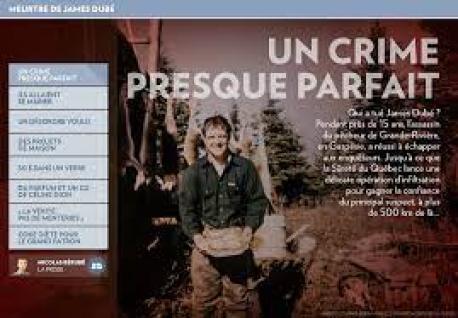 JAMES DUBÉWho killed James Dubé? For nearly 15 years, the murderer of the fisherman from Grande-Rivière, in the Gaspé, managed to escape investigators. Until the Sûreté du Québec launched a delicate infiltration operation to gain the trust of the main suspect, more than 500 km away …NICOLAS BÉRUBÉ
JAMES DUBÉWho killed James Dubé? For nearly 15 years, the murderer of the fisherman from Grande-Rivière, in the Gaspé, managed to escape investigators. Until the Sûreté du Québec launched a delicate infiltration operation to gain the trust of the main suspect, more than 500 km away …NICOLAS BÉRUBÉLA PRESSESEPTEMBER 24, 2017
GRANDE-RIVIÈRE – It is almost 3 am when James Dubé opens his eyes to begin what will be the last day of his life.
Taking care not to wake his two daughters, his partner by his side, the fisherman puts on his work clothes and leaves his house. He climbs aboard his white Ford pickup truck and drives along Route 132 for 3 km, to the Grande-Rivière wharf.
With his fishing partner Gilles Lebreux, James Dubé climbs aboard his boat. Dressed in coats to protect them from the cool night of April 30, 1998, the two men set sail to retrieve their lobster traps.
“James was pulling up the cages, and I was emptying them and putting a mackerel bait back in,” recalls Gilles Lebreux. We had 250 cages. We had to work quickly, we didn’t talk much. “
After fishing, James Dubé sells the lobsters to the Grande-Rivière fish factory, of which he is one of the co-owners. Later, he climbs back into his truck to return home, to his brown brick bungalow facing the sea, on Route 132.
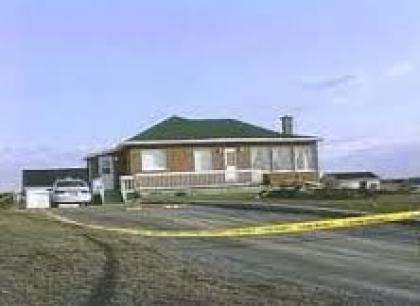 Brown brick bungalow on Route 132
Brown brick bungalow on Route 132At 37, James Dubé is at his peak. The easy smile, the strong handshake, he is known to everyone in Grande-Rivière, the city where he grew up. Seven years earlier, his father, Raymond Dubé, also a lobster fisherman, got caught in a net that pulled him into the winch of his boat, killing him instantly. This did not discourage his son from returning to sea with the same boat and practicing this profession which allows him to go moose hunting in the fall and to take snowmobile trips through the Gaspé in the winter.
“When James came in somewhere he would take his place, he was imposing,” recalls one person who knew him and who wishes to remain anonymous. “Let’s say there’s no one going to knock him off his feet. “
Three weeks earlier, James Dubé and his wife Johanne Johnson delighted in showing friends over dinner an engagement ring. “They were going to get married. It was a great time for them. “
Around noon, Johanne Johnson arrives home with two submarine sandwiches she bought at the convenience store. They have sex. Ms. Johnson, who works at the lobster factory, cannot stay any longer: she has to go to work. James Dubé lies down for a nap with his arms crossed on the living room sofa.
A few hours later, André Dubé, the older brother of James, owner of a auto body garage in Grande-Rivière, is about to paint a client’s car when the phone rings in the office. A co-worker answers, then tells him that something serious has just happened at James Dubé’s home.
A DESIRED DISORDER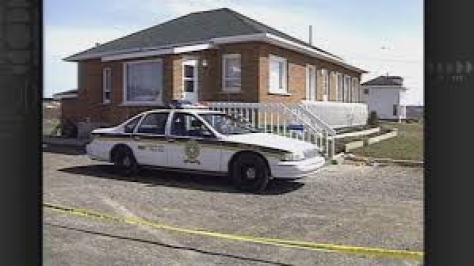
André Dubé jumps in his car and arrives at his brother’s place in less than five minutes.
“I park in the driveway and see police and paramedics everywhere. There were about twenty people there. I was not allowed to enter the house. “
One hundred and fifty kilometers further south, investigating agent Guy Lebel, from the major crimes office of the Sûreté du Québec for eastern Quebec, is on his way to Rimouski when he receives a call telling him to turn around and go to Grande-Rivière.
It is around 5 p.m. when Guy Lebel parks his car in front of James Dubé’s bungalow. SQ investigators from the Pabos station guide him inside, to the living room, the center of interest for everyone on site.
“I see a man lying on the couch, lifeless. He’s dressed in jeans, he’s dressed like a worker. He has a gunshot wound to the head. The house appears to have been searched. There are pots on the floor. It was his oldest daughter who found him. She cries and she panics in the kitchen. “
Alerted at her work, Johanne Johnson arrives by car. “She seemed to be in shock,” says Lebel.
SQ police set up a roadblock on Route 132 and search all cars in the area, looking for the murder weapon. Investigators interview neighbors, co-workers and family members of James Dubé to get a picture of his day.
Guy Lebel establishes a security perimeter around the house. He and the Forensic Identification Service are searching the ground floor, basement and large grounds. “We were looking for things where there might have been blood, but not much was found. “
Guy Lebel worked for almost 10 years at Pabos SQ post, a seven-minute drive from the house where the murder took place. He has crossed paths with James Dubé several times. “He and his brother weren’t coming up on our radar. They were people who worked, who made their living. “
At the scene of the murder, a detail surprises Mr. Lebel.
“The TV, the hunting guns in the basement… Everything was still there. I found that strange. Usually, valuables go first. And the pots on the floor… Something was wrong. The house was a mess, but it wasn’t a normal mess. It looked like a deliberate mess. “
HOUSE PROJECTS
In addition to plunging him into a state of shock, the murder of his brother explodes a series of questions in André Dubé’s head.
” Who did that ? Was there a quarrel with another fisherman? Is it a woman’s story? Will the person who did this come back? “
James was his best friend, he said. “We were always together. We were almost like twins. “
A few days after the murder, James Dubé’s neighbor accidentally falls in his basement. He cuts himself on the neck on the wall of an aquarium and dies.
“It added to the climate of paranoia. We were like, what is going on here? It’s a small place. I’m not a nervous person, but for a month after the murder, I turned on lights everywhere at night. Inside and outside. I was not at ease. “
André Dubé and his wife welcome Johanne Johnson and her two daughters to their home. Very quickly, Mr. Dubé was surprised at his sister-in-law’s attitude.
“Johanne was not asking any questions about James’ death. She was cold, indifferent. She wasn’t crying. ”
André Dubé is also amazed to see his sister-in-law return to take a shower in the house where her husband was shot a few days earlier.
A few days after the murder, Johanne Johnson is on the phone shopping for a car for her daughter, a purchase that James Dubé opposed before his death, says André Dubé. “The next day she was talking about having a house built. Me and my wife at the time, we found that this was not normal. “
The afternoon he died, James was scheduled to go to the solicitor to sign the papers and dissolve the lobster factory business, André Dubé recalls.
“By the same token, he would have lost his life insurance. By not leaving the house that day, the shareholders, including Johanne, saw their debts paid and received life insurance if one of the shareholders died. “
The autopsy shows that the rifle that was used to kill James Dubé was a 22 caliber, the same as a rifle the fisherman kept on his boat that had been stolen in the weeks before the murder.
Investigators probe to see if a fisherman could be responsible, but find nothing. Police ask Johanne Johnson to take a polygraph test. She refuses, repeating that she had nothing to do with the murder of her future husband.
Months go by, then years. One observation begins to emerge: the murderer did not leave enough traces for their identity to be revealed.
$50 IN A GLASS
14-years later, on December 5, 2012, Johanne Johnson gets out of her car in front of her new partner’s house in Rivière-du-Loup shortly after 3 p.m.. She notices a woman standing near a car parked in the street.
She asks her if she needs help. According to documents filed with the Superior Court of Quebec last year, the woman replies “that she is lost, that she is looking for her sister whom she has not seen for a long time to tell her that their mother is deceased”.
Johanne Johnson offers to help. The woman accepts and the two women undertake to crisscross the neighborhood by car.
Johanne Johnson doesn’t know it yet, but the disoriented stranger she just put in her car is an undercover officer for the Sûreté du Québec.
A grand merry-go-round launched by the SQ’s cold case team with the participation of the Royal Canadian Mounted Police and the Montreal Police Department has just started.
This is the eighth time in more than two weeks that an approach has been attempted. But, each time, Johanne Johnson’s comings and goings do not [allow] the officer to approach her.
As the car drives through the streets of Rivière-du-Loup, the officer, identified by code SQ0902 in investigative documents, shows Johnson a photo of her sister. She offers Johnson a $50 bill. Johnson refuses, saying “this is help.” The agent puts the money “in a glass in the middle of the console.”
For nearly two hours, the two women talk. Johanne Johnson, then 52, talks about her health problems, her daughters and her grandchildren. She explains that she is on sick leave.
At around 5 p.m., they returned to Johanne Johnson’s home. Agent SQ0902 offers her a second $50 bill, which she again refuses. The agent places the ticket “in the same place as the other”. A reward of $500 will be given to whoever helps her find her sister, she tells Johnson.
The two women exchange their phone numbers. Johanne Johnson volunteers to continue the search “Mondays, Wednesdays and Fridays”.
PERFUME AND A CÉLINE DION CD
Over the next few days, Johanne Johnson and Agent SQ0902 saw each other regularly. The two women continued their research before going to lunch and dinner in restaurants. Agent SQ0902 pays the bill.
The agent gives Johnson $50 and $100 bills to thank her for taking the time to help find her sister. The latter accepts the money, which she promises to use to “spoil [her] grandchildren.” The two women become friends.
During their conversations, Johnson is “in a good mood” and “talks easily about her private life”.
She says she was the victim of domestic violence from her “ex” and says that the latter “died in an accident”.
She says she does work for the elderly at a community health center. Johanne Johnson says she has struggled with alcohol and gambling in the past.
The two women work for over a week when Agent SQ0902 received a call. She must go to Montmagny to pick up a vehicle to bring it to Lévis. “Johanne Johnson is informed that SQ0902’s spouse has a company and that SQ0902 works for him,” read the transaction report.
Officer SQ0902 asks Johanne Johnson if she can drive the vehicle for her, that she will be paid for this service, which she accepts. The agent “offers her the job” at the company on the spot.
Johanne Johnson moves vehicles from city to city. Each time, she gets paid in cash. So much so that she says one day that she “will get rich” by doing work like this.
On December 20, Agent SQ0902 surprises Johanne Johnson with a gift: perfume and a Celine Dion CD. Johnson tells Agent SQ0902 that she is “a godsend.”
Gradually, the nature of the work entrusted to Johanne Johnson by Officer SQ0902 begins to change.
Johnson has to transport a suitcase by bus from Rivière-du-Loup to Sainte-Foy. Later, she will move a suitcase that is in the trunk of a car. You can’t say what’s in the suitcases, but “it’s not drugs.” She also meets the agent’s spouse, identified as DG876, and other alleged members of the organization.
Johnson accepts the tasks and can earn $400, $500, or even more for a day’s work.
Johnson agrees to carry a suitcase that contains weapons. To celebrate, the group is treating themselves to hearty dinners in upscale restaurants, including La Bête in Quebec City.
On January 29, while in Montreal for a delivery, the group took the opportunity to attend a hockey game at the Bell Center, a first for Johanne Johnson. The Montreal Canadiens won 4-3 over the Winnipeg Jets. Johnson “doesn’t like hockey, but enjoys her night. […] [She] is in a good mood, ”the report notes.
“THE TRUTH, NO LIES”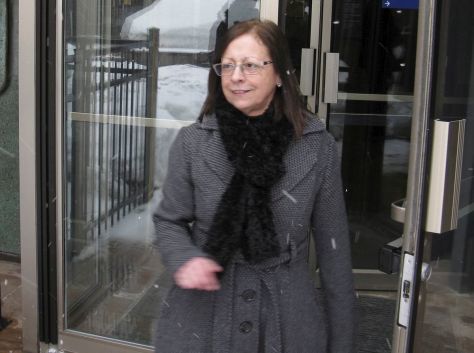 Photo: Genevieve Gelinas Johanne Johnson subit son proces pour meurtre au palais de justice de Perce.
Photo: Genevieve Gelinas Johanne Johnson subit son proces pour meurtre au palais de justice de Perce.
Johanne Johnson learns that a ‘big job’ awaits her if she can live up to it.
Before having access to this “big job”, she must meet the big boss of the organization. This meeting takes place on June 19, 2012 in a cottage in New Richmond, on the edge of the Bay of Chaleur in the Gaspé.
En route, Agent SQ0902 stops at Tim Horton’s in New Richmond. She phones the big boss. Back in the car, she is upset. “There is something wrong here. The big boss is not in a good mood.”
Johanne Johnson asks “if something bad is going to happen to them. […] SQ0902 reassures her that nothing will happen to them physically and not to “screw up” ”.
During the meeting, the boss affirms that things are getting “warm” for the group. “I just found out about that. These are all things we could have avoided. Because the heat does not come from the rest of us there. The heat is coming from your friend here, ” he said, turning to Johanne Johnson.
The boss says “it’s worse than he thought and it’s about her ex who was killed.”
The two agents leave the room. Johanne Johnson is alone with the big boss.
The big boss is “respectful. There is no confrontation or intimidation “, say the notes of the Sûreté du Québec.
“If you want me to help you there, […] you’re going to start telling me what happened that day from A to Z, he said. The truth, no lies because if you tell me a lie, that’s it. What happened? […] “
J.J: “The day James died? “
Boss: “Yes”
J.J .: “I killed him.”
Boss: “How did you kill him? What happened ? Because. “
J.J .: “Well there [inaudible] there was so much pressure on me [inaudible]. “
Boss: “Ok. […]. “
J.J. “This is the first time I say this. “
DIET COKE FOR THE BIG BOSS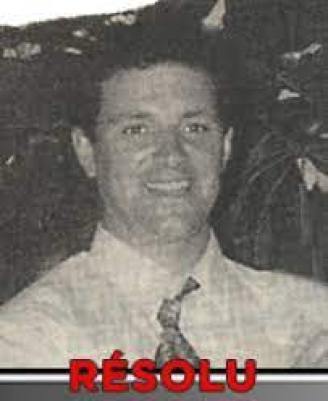 James Dube
James Dube
The big boss asks her why she killed her partner that day.
“[I] didn’t decide when, it just happened. It happened like a flash, ”she replies.
She says she killed James Dubé while he was taking a nap, lying on the couch. She shot him in the head with a 22 rifle. “After killing James Dubé, Johanne Johnson threw pots on the ground to simulate a fight,” the report notes.
“She picks up the gun, rolls it up in a rug, walks out the back of the house, gets out of the car, and takes the gun into the woods at Chandler about fifteen minutes from her house. “
Johanne Johnson says she inherited her husband’s fishing boat, which she sold for $175,000, and $30,000 in life insurance. She says she spent two or three years on drugs to try to forget. “She felt followed by the police. She spent the inheritance money on drugs. She gave her father $30,000 to pay off his debts. She spoiled her daughters. “
Johnson also tells the big boss of being worried when summer arrived that the gun will be found and someone will come knocking on her door.
After the meeting, the big boss asks two members to accompany Johanne Johnson in the woods off Pellegrin road, in Chandler, where she says she got rid of the weapon, just to try to locate it and make it go away for good. The group goes there, but fails to locate the weapon.
On the way back, the group stops at a Chandler IGA, and Johanne Johnson is told to go in and buy “Diet Coke and Chocolate Chip Cookies” for the Big Boss. When she comes out of the grocery store, Johanne Johnson is arrested for the murder of James Dubé.
EPILOGUE Johanne Johnson
Johanne JohnsonOn April 13, 2016, after three days of deliberation at the Percé courthouse, a jury composed of five men and seven women found Johanne Johnson guilty of the second degree murder of James Dubé. She was sentenced to life imprisonment without the possibility of parole for 11 years.
 Palais de Justice = Perce, Quebec
Palais de Justice = Perce, QuebecJohanne Johnson filed for an appeal which was authorized by the Quebec Court of Appeal. The final dossier has not yet been submitted.
During her trial, she claimed to have nothing to do with the murder and said she lied to the big boss for fear of dying.
Her lawyer, Me Rodrigue Beauchesne, maintains that her client is a victim.
“With the Operation Mr. Big trap, the police made her say what the police wanted to hear. Mrs Johnson is a citizen, and in front of the whole machine, she was no match. “
During the undercover operation, which lasted over six months, Johanne Johnson received approximately $18,000 in cash for the work performed and was reimbursed $2,400 for her expenses.
Even today, André Dubé says he is stunned when he realizes that his ex-sister-in-law shot down his brother during his nap.
“It was in cold blood. If it had been done with drinking or on drugs … But it was around noon, so she was sober. “
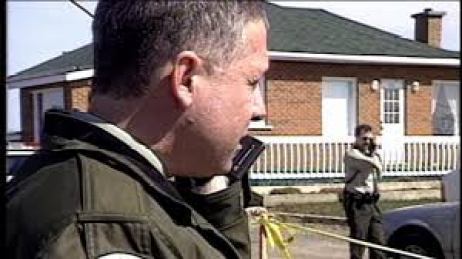 Brown brick bungalow on Route 132
Brown brick bungalow on Route 132He says he doesn’t feel angry at her. “Now she is paying for what she did. “
Guy Lebel, the first member of the Major Crimes Unit to arrive at the scene of the murder, recalls feeling “relief” when he learned that Johnson had been arrested, 15 years after the murder.
“I said to myself: We were right. The investigation was right. “
The person who comes close to committing the perfect homicide is the one who acts alone, he says.
“Whoever does it alone, there is no one who can tell it. If they don’t speak, it doesn’t come out. In the case of Johanne Johnson, she could have taken it with her to her grave, that secret. “
WHAT IS A “Mr. BIG” OPERATION?A “Mr. Big” operation is an investigative method designed to trick a suspect into believing that they are about to join a criminal group, and is used to extract a confession from them. At least 350 operations of this nature have been carried out over the past 30 years in Canada. In 2014, the Supreme Court upheld the validity of Mr. Big operations, while restricting their admissibility in evidence. Critics of the use of these operations argue that the mere participation of a suspect in a Mr. Big-type operation is likely to mar credibility in the eyes of a jury.
To see the Surete du Quebec’s notice on the case click here.
CODALA TRIBUNE
AUGUST 3, 2020
 Johanne Johnson
Johanne JohnsonA Gaspé woman, Johanne Johnson, found guilty of the unpremeditated murder of her husband James Dubé, will be entitled to a second trial. The Court of Appeal found that the judge at the first trial erred in presenting the statement of an important witness to the jury.
Johanne Johnson, 58, was convicted in April 2016 of the murder committed 18 years earlier.
On April 30, 1998, lobster fisherman James Dubé was shot in the head with a 22 caliber rifle bullet while taking a nap on the living room couch in his home in Grande-Rivière, in the region.
Johanne Johnson was arrested only in 2013, after a “Mister Big” undercover operation. The lady had confessed to the murder of her husband to the head of this false criminal organization, personified by a police officer.
She was charged with premeditated murder.
At trial, she said she confessed to a murder she did not do because she feared for her safety. The accused also said that she was beaten for several years by James Dubé.
Sentenced to life imprisonment without the possibility of parole for 11 years, she appealed the verdict.
A lack of direction
The highest court in Quebec has just ruled in his favor and ordered a new trial on a very specific point.
The Superior Court judge who heard the trial erred, the judges say, in presenting the accused’s daughter’s statement to jurors.
Jackie Dubé, a crucial witness for the prosecution, had read during the trial observations on her mother’s behavior as well as recounted confessions made by Johanne Johnson after the arrest.
According to the Court of Appeal, the judge would have had to justify the admissibility of the girl’s notes into evidence and give the jury specific instructions. “Taken together, these two errors carry an obvious risk of harm,” wrote the Court of Appeal. Their cumulative effect is far from minor, and its influence on the jury’s deliberations is incalculable. Without these errors, it is not possible to conclude with certainty that the evidence presented against the accused was so overwhelming that it would have been impossible to reach a further verdict. “
RADIO CANADA
Joanne Berube
April 19, 2021
The first part of the second trial of Johanne Johnson, accused of the murder of her husband James Dubé, ended last week at the Percé courthouse.
The proceedings, which began on March 15, took place behind closed doors and were subject to a publication ban. The judge reserved the case.
The continuation of the trial has been set for October 4 for eight weeks and should begin with the selection of the jury.
James Dubé was found shot dead in the back of his neck at his home in Grande-Rivière in April 1998, but it was not until 15 years after the incident that his wife was charged with the murder.
Johanne Johnson was then found guilty of premeditated murder and sentenced to life imprisonment in April 2016.
In the summer of 2020, the Quebec Court of Appeal ordered a new trial due to the admission at the first trial of certain evidence and the lack of instructions to the jury in connection with this evidence.
The post MURDER OF JAMES DUBÉ AN ALMOST PERFECT CRIME / WKT5 #12 first appeared on WHO KILLED THERESA?.July 24, 2021
Siasi Tullaugak – “a violent death”, not suicide
 Siasi Tullaugak
Siasi TullaugakA 2019 coroner’s report on the death of a 27-year-old Inuit woman determined “This is a violent death”, not suicide as initially ruled by the Montreal Police, the SPVM.
Siasi Tullaugak was found hanging from the small balcony of a Chomedey Street apartment on August 29, 2017. Within 24 hours, another Inuit woman, Sharon Baron’s body was found hanged in a closet inside her apartment in Dorval. In both cases the Montreal police considered the deaths of the two Inuit women as suicides. People who knew the two women said they suspected foul play, but when they tried to communicate this to the police their information was brushed aside.
In the case of Baron, the Quebec coroner eventually ruled her death a suicide. In a March 2018 report, Dr. Louis Normandin wrote that Sharon Baron hung herself with a computer power cable, concluding that she died of compression asphyxiation of the neck structures following the hanging, finally determining, “It is a suicide.”
Tullaugak’s coroner’s report was filed over 14 months later, even though both victims died within 24 hours of each other. In May 2019 coroner Karine Spenard wrote, “Siasi Ikidluak Tullaugak died of suffocation by hanging”, then concluded “This is a violent death.” The report goes on to say that it is not the role of the coroner to pronounce the civil or criminal person responsible in such matters, and, as this is “still an open file at the SPVM”, the analysis of the event remains open.
In 2017, the Montreal police’s Aboriginal liaison officer, Carlo De Angelis insisted police had thoroughly investigated the cases, “… investigators have done the legwork on this. They’ve looked at all the information that was gathered.”
Both Tullaugak and Baron were known to frequent the Cabot Square district on the edge of Montreal’s west end. The park is well known for drugs and sex trafficking. On March 26, 2019, another Inuit woman, Donna Pare was reported missing. Pare was known to frequent Place Emilie Gamelin, another area known for drugs and prostitution. She has not been seen since December 2018.
The SPVM’s media relations division declined to comment on the matter, instructing that all questions be put to the police force through an access to information request.
MORE DETAILS ON THE CORONER REPORTS
The post Siasi Tullaugak – “a violent death”, not suicide first appeared on WHO KILLED THERESA?.


